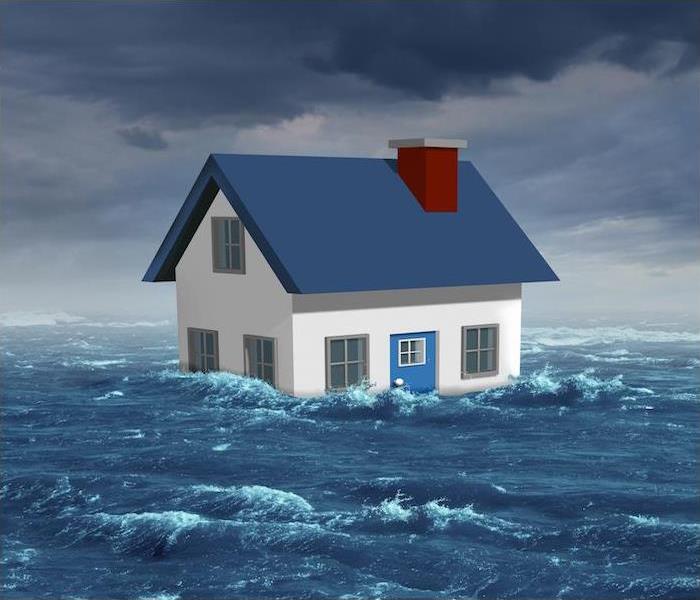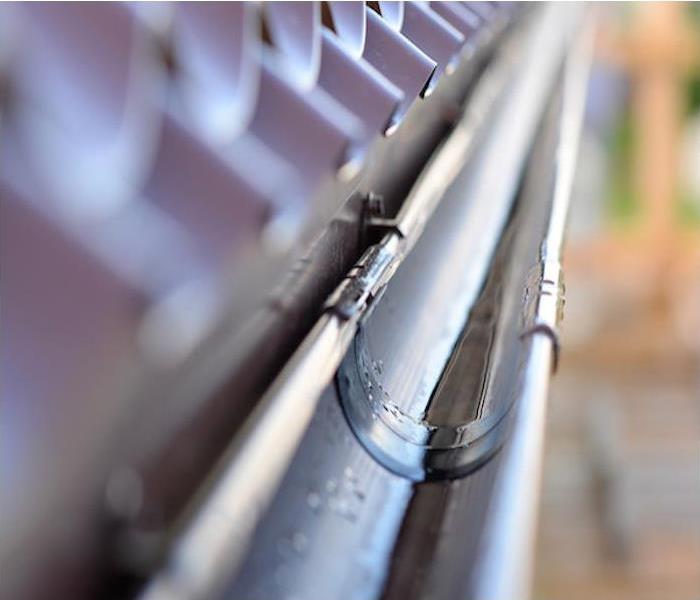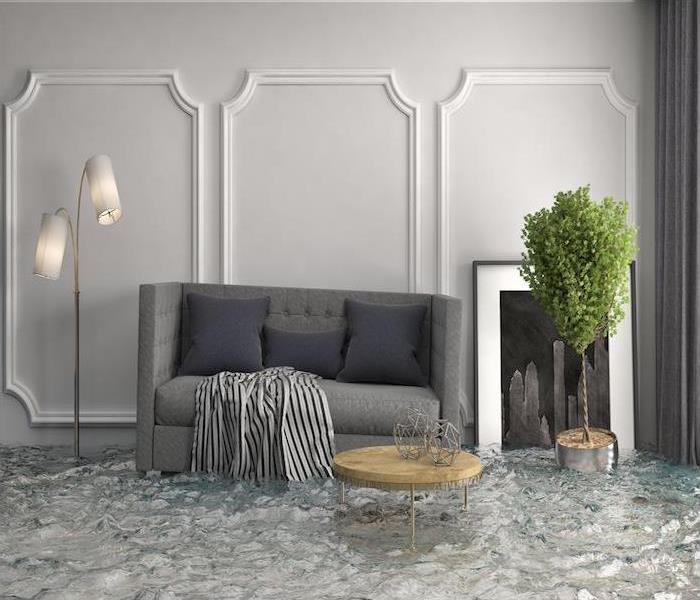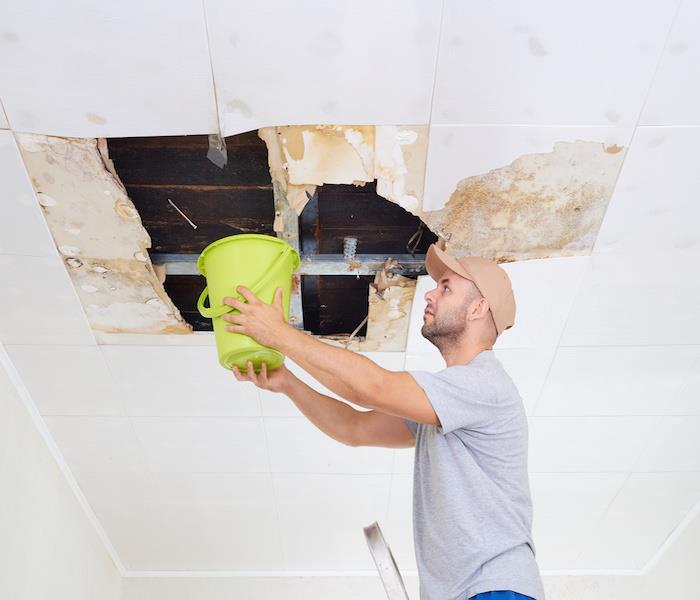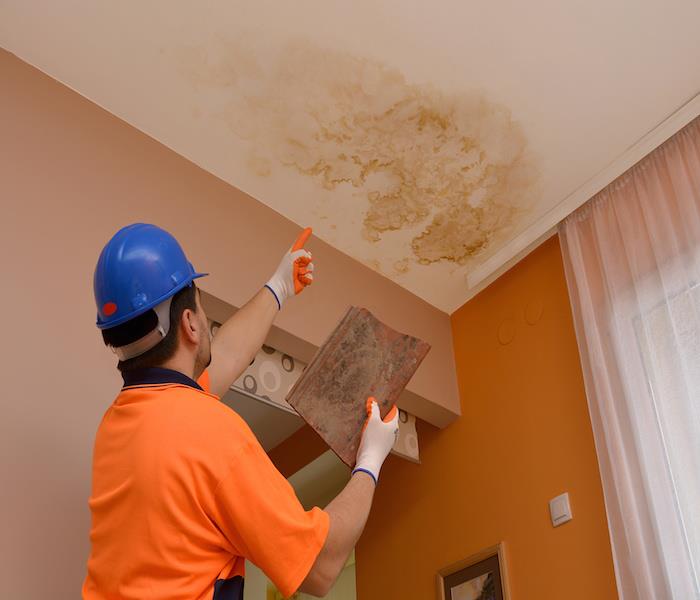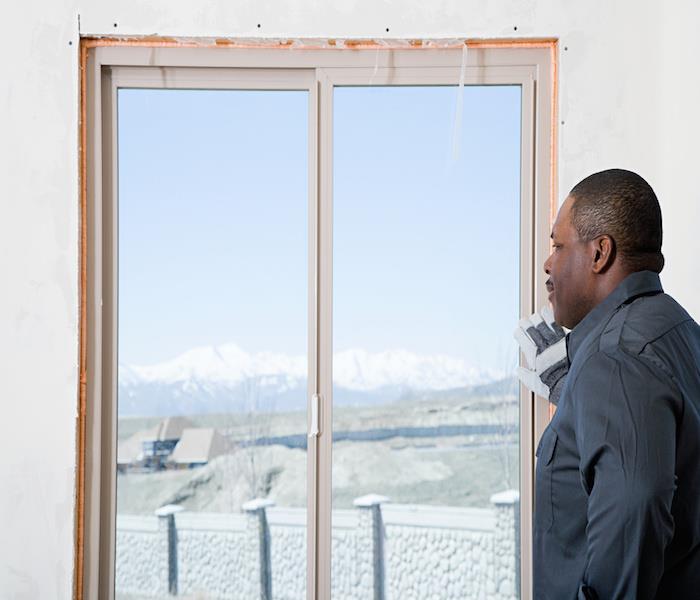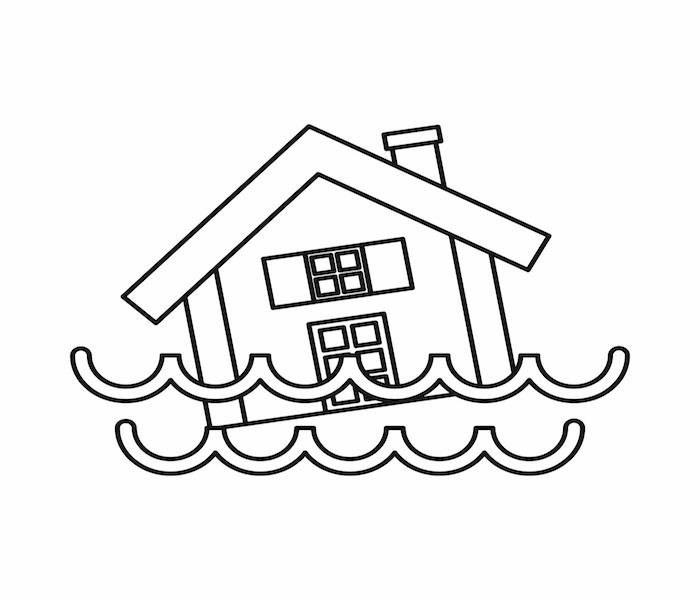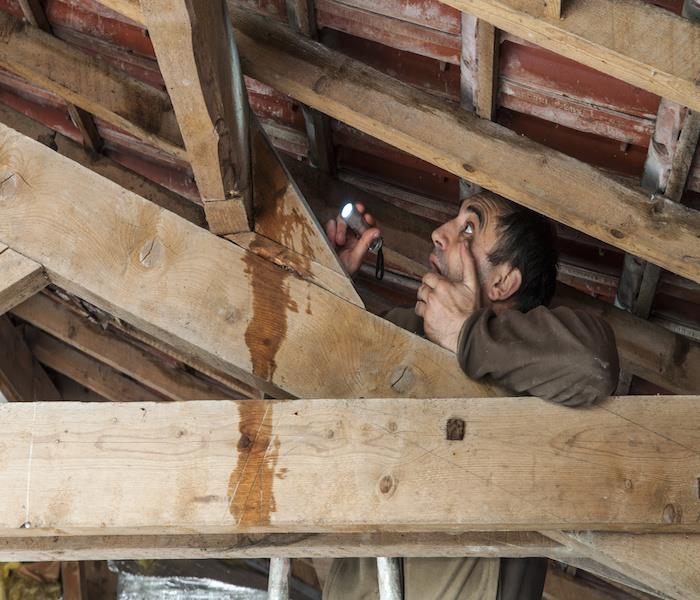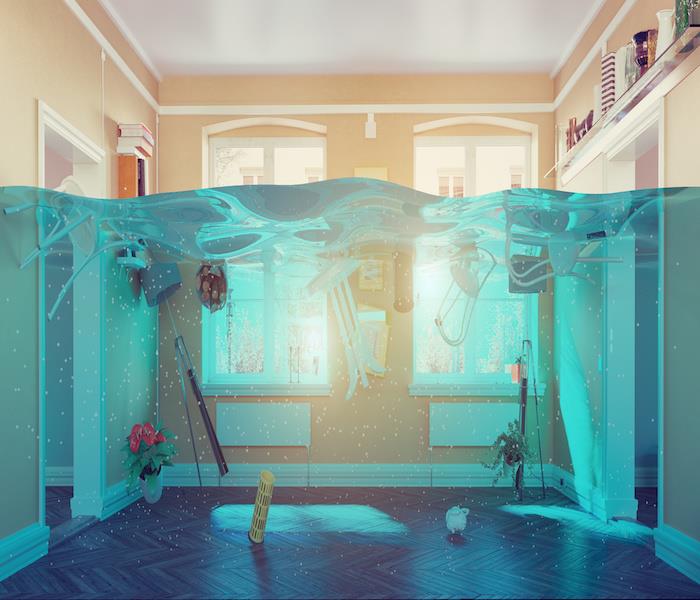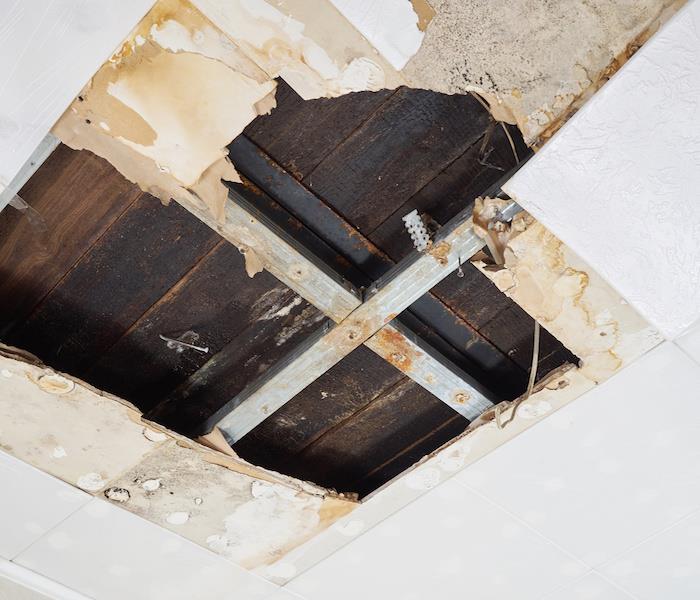Recent Water Damage Posts
Viera Water Damage Restoration
3/4/2024 (Permalink)
How SERVPRO® Restores Your Water Damaged Property in Viera
Viera water damage is one of the most devastating household incidents that a property owner can encounter. Because the damage can turn your property upside down, it's no surprise that many homeowners struggle to maintain their emotional stability as they start the restoration process. Despite the challenges that can surface when you discover water damage on your property, you can simplify and streamline the remediation process by hiring excellent restoration services from a qualified company like SERVPRO. Learn more about how this water extraction company can assist you by reviewing the following outline:
The Assessment
The first move water damage restoration experts will do upon arriving on your property is a thorough assessment. This evaluation provides contractors with clear information regarding the extent of damage done to your property, and any sources of continuing water intrusion. Once the inspection is complete, our representative will be able to devise a clear strategic plan that outlines how we will remove standing water, dry furnishings and building materials, and other restoration processes. SERVPRO has an industry leading method called the CCIS-Contents Claim Inventory Service. This will document all damages as salvageable, non-salvageable, or questionable. This precise listing allows you, along with your insurance company, to decide on how to move forward with the water damage restoration process. We will work with your agent to offer you a stress-free claims process while keeping costs down.
Structural Damage Repair and More. Water extraction of standing water and moisture removal are necessary before cleaning and repairing. The quicker water is extracted; the less damage will occur. This removal will lessen the chance of unwanted mold from growing on your property. Specialized equipment such as air-moving machines and industrial-grade dehumidifiers are put in specific locations. Unfortunately, water damage can often cause sagging ceilings and warped walls. Additionally, water damage can weaken your home's structure, and compromise the electrical, HVAC, and plumbing systems. Repairing and restoring damaged building materials, whenever possible, is preferred to replacing, thus mitigating cost and time.
Call SERVPRO Immediately. Water damage to your Viera home is not an issue that should be taken lightly. Your best course of action once water damage has happened is to call the professionals of SERVPRO. Our IICRC-certified professionals will offer you diligent restoration work that gets your home back into preloss condition "Like it never even happened."
Highly-Trained Water Restoration Specialists
SERVPRO of West Brevard uses advanced water removal equipment to dryout out your home in Viera, Suntree, or Palm Shores. We proudly serve our local communities. Just call for help. 321 953-8600
Why a Professional Should Treat Water Damage
3/4/2024 (Permalink)
If you’ve suffered flood damage or a plumbing disaster, cleanup is most likely required to restore your home. In these cases it’s important that only a certified professional handles the cleanup. The existence of excessive moisture could create problems with long-lasting effects, even if the soaked materials have been removed from the home. It’s even more important that a professional restoration crew cleans up the damage if the moisture comes in with a flood or some other contaminated source because bacteria, viruses, and molds can thrive within organic materials such as carpet, upholstery, drywall, and wood. The microbes that live in these environments can cause serious harm to occupants of a home.
You may have the idea that you can dry out your home and the materials in your home well enough that you don’t need a professional restoration crew. But the technicians that handle the cleanup will use their special skills and equipment to ensure that all potential health hazards are eliminated when you return to your home. It’s important that you hire technicians like those at SERVPRO who are certified by the Institute of Inspection Cleaning and Restoration Certification (IICRC).
The first thing the restoration crew will do when they arrive will be to assess the extent of the damage to see exactly what they are dealing with and what needs to be done. Once the technicians discover the source of the moisture, they will isolate a work area and immediately begin to remove any standing water. In the case that there are several inches of moisture present, the technicians will need to use a commercial pumping system to dry the area as much as possible. This type of equipment must be used in situations such as when a pipe burst and floods a basement.
Next the technicians will survey the area where there is water damage to see if they need to dispose of any materials that may have been destroyed. Usually if there are any organic materials that have become wet or contaminated, they will need to be eliminated. If the treatment of the items is quick enough, there may be an opportunity to save some of them. Typically items like carpet, baseboards, casings, portions of drywall, plywood, and particle boards won’t survive if they’ve been exposed to contaminated moisture for an extended period of time. After 24 hours, mold growth can happen rapidly so many materials are beyond repair if they’ve been exposed to contaminated moisture for a day or longer.
After everything that needs to be thrown out has been, the only materials that are left should be those that can be dried and restored to their original state. The goal of the restoration crew will be to wick off as much of the moisture that remains in the shortest amount of time possible to minimize the amount of damage. They usually are able to accomplish this by the use of commercial air movers and high volume humidifiers which allows them to restore the building to a normal moisture content in a few days.
In some unique situations, special equipment like heat injectors might be required in order to dry areas that are harder to reach. However, usually air movers and dehumidifiers work well enough. The technicians that are completing the drying process will use a moisture meter, built with probes that are designed to be inserted into the wet materials, to monitor their progress. Once the drying process is completed and a normal level of moisture content has been restored in the home, the technicians will deconstruct the work area, clean up, put all furniture back, and properly dispose of any refuse.
Due to the fact that cleaning up the water damage must also address microbial growth, the technicians completing the restoration will be prepared to eradicate molds and other microorganisms. They’ll apply special agents to areas around the home that they suspect may be harboring the pathogens. Once the restoration crew is finished restoring the home and has vacated, the house will once again be livable.
Water damage has the dual effect of damaging personal property as well as being harmful to the health of residents. The restoration of water damage should always be handled by professionals that are certified by the IICRC so that the home is fully livable and safe for the occupants to return. If you have water damage in your home or need some other form of restoration, call the reliable professionals SERVPRO®.
Viera Black Water Damage Restoration
7/1/2022 (Permalink)
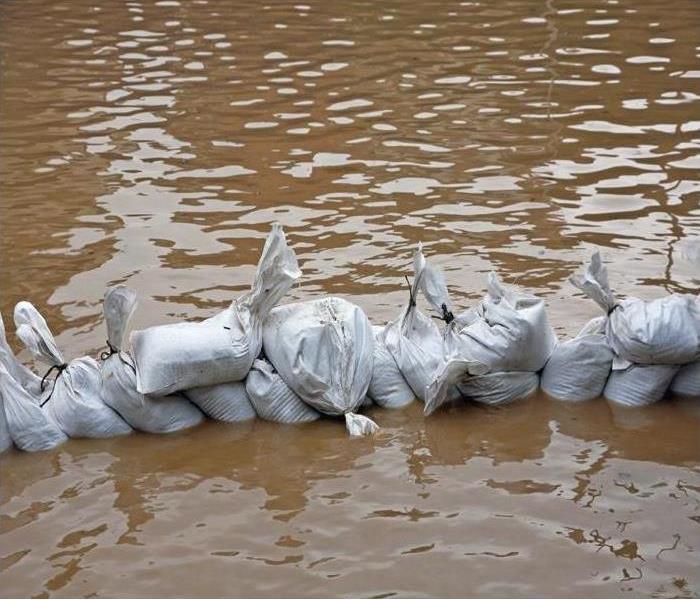 When flood water has different contaminating agents, as well as viruses that can present severe health risks, it is referred to as "black water."
When flood water has different contaminating agents, as well as viruses that can present severe health risks, it is referred to as "black water."
Black Water Damage Restoration
When flood water has different contaminating agents, as well as viruses that can present severe health risks, it is referred to as "black water." In many areas of the United States, flooding is a serious risk, and Viera black water contamination is always possible. Storms, hurricanes, and the thawing of snow can all contribute to floods by leading to rising water from natural bodies of water and causing sewage back-flows.
If you want to remediate Viera black water contamination that is present in a building, it is best to contact SERVPRO. The task will necessitate a great deal of copious planning, and specialized equipment will be needed. A licensed contractor will have the expertise to assess the situation, as well as clean and dry the necessary locations. The following is a list of steps that should be followed in the case of black water damage:
1. Make sure that all building workers and other occupants are safe. Anyone who is working will need to don protective equipment, such as eye protection, boots, gloves, respirators, and waterproof coveralls.
2. The contractor who was hired must thoroughly inspect all of the affected areas to be able to assess the seriousness and nature of any damage, which will have an impact on the remainder of the restoration process.
3. Excess Viera water needs to be removed as quickly as possible, in order to prevent any further damage. It is also important to remove the sewage, contaminated porous materials, and any other waste. Negative air machines, air scrubbers, and other specialized tools may need to be utilized to stop the contamination from spreading. EPA-approved disinfectants will be used on affected surfaces.
4. Once the contractor has finished sanitizing, a balanced drying system will be put into place to restore damaged areas to their former conditions. Specialized procedures will be used here, as well as specialized equipment and products, including high capacity air movers and professional dehumidifiers.
In all situations of property damage, including that of black water contamination, contact the local SERVPRO office. These professionals will provide services to restore properties after disasters and minimize the overall losses.
Our Water Damage Restoration Process
Since every flood and water damage scenario is a little different, each one requires a unique solution tailored for the specific conditions. However, the overall water restoration process remains the same. The steps below detail our restoration process for the typical water-damaged property.
Step 1: Emergency Contact
Step 2: Inspection and Damage Assessment
Step 3: Water Removal/Water Extraction
Step 4: Drying and Dehumidification
Step 5: Cleaning and Repair
Step 6: Restoration
How Professionals Handle Water Damage Clean Up in West Brevard
5/2/2022 (Permalink)
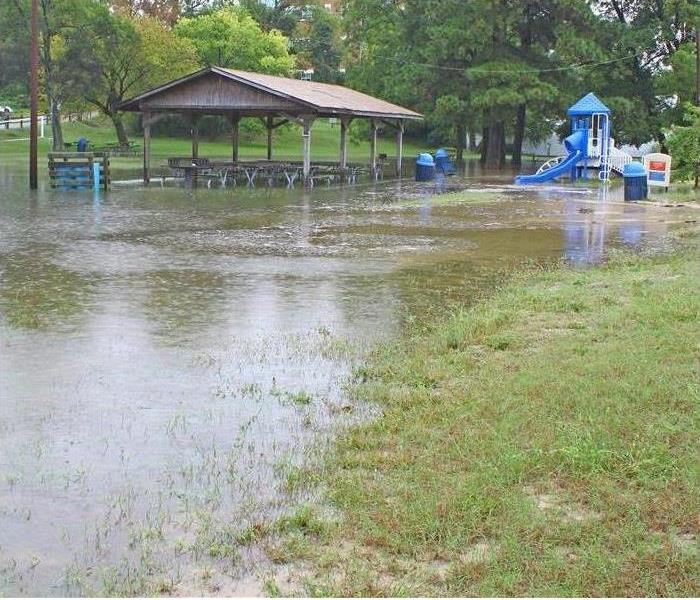 If Too Much Water Has Gotten You Down, Call SERVPRO for help!
If Too Much Water Has Gotten You Down, Call SERVPRO for help!
In the tragic event of a flood or a plumbing failure, a high-quality water damage cleanup and restoration service can be the best solution. The services offered by an expert repair team is crucial in resolving the issues in your home.
It is often imperative that water damage restoration is sought after flooding, because even when standing water is gone, excessive dampness and moisture continues to cause significant problems. If your home has been filled up with flood water from a nearby river or canal, it will likely leave behind contaminants, dirt, and other debris.
Bacteria, viruses, and mold, can very quickly gain a foothold in carpets, drywall, and upholstery. Therefore, it is important to seek the help of professionals that can eliminate these unwanted guests. The following section will explain what professional water damage clean up usually entails.
Reviewing the Damage
There are many of hazards linked with water damage clean up, so a restoration team from SERVPRO, must first get a good look at the water damage and assess all the variables associated with the final clean up. Determinations are made whether the area is likely to be contaminated, how critical a threat it poses to the occupants, and what is the best way to mitigate continuing water damage.
Removing Standing Water
If standing water is present in the building, the water damage crew will use industry-grade pumps, wet vacs, and sump pumps for the extraction. You will be expected to vacate the area until the restoration job is complete or until it is safe for you to be on-site.
Drying Out a Wet Environment
After wrapping up and discarding any materials and possessions that cannot be salvaged, the team will attempt to dry out the environment as quickly as possible. They will do this with dehumidifying equipment and heavy duty fans and air movers. In some cases, tools like heat injectors will be brought into dry hard to reach areas. The progress will be continually assessed using moisture reading instruments and devices. The final drying time may take from several days to over a week.
Killing Off Bacteria, Mold, Germs, and Odors
The final steps, once the area is dry and moisture levels have returned to acceptable levels, is to apply antimicrobial and antifungal agents, for sanitation. Foggers will disperse odor destroying products to give your home a clean smell.
Welcoming the Family Back
Once all of the above steps have been completed, the occupants of the water damaged property will be allowed to return. The IICRC, trained water damage restoration experts from SERVPRO of West Brevard, will complete a final walk-thru with the homeowner to ensure complete satisfaction with the water remediation process. We are confident that you will feel "Like it never even happened."
We are Highly Trained Water Damage Specialists
SERVPRO of West Brevard, are water damage specialists who get started promptly to get your property dry and back to pre-fire or water damage condition. Using advanced water removal and drying equipment and scientific drying principles to get your property dried quickly, we document the drying process to validate your home or business is ready. We are members of the local communities and are ready 24/7 to help. 321-953-8600
Palm Bay Water Damage Inside Your Home Can Cause Your Expensive Appliances To Fail
2/7/2022 (Permalink)
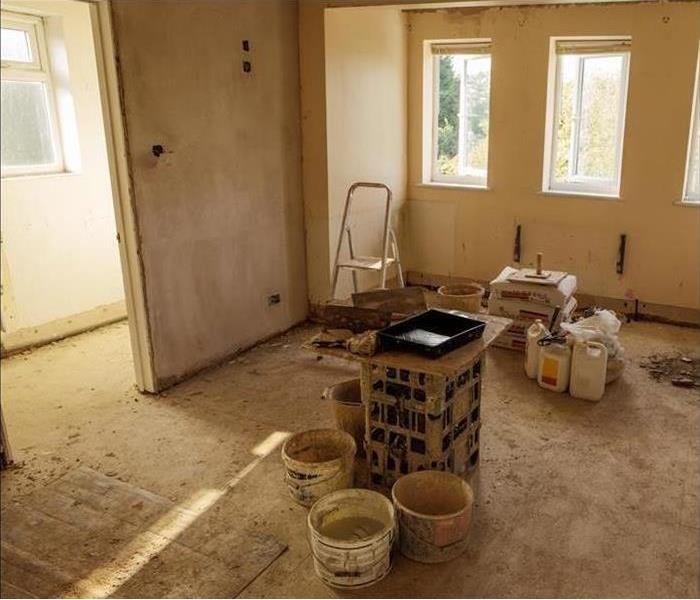 Water damage tips include, finding the actual source of water leakage!
Water damage tips include, finding the actual source of water leakage!
The Dangers Of Palm Bay Water Damage
Water damages thousands of homes each year due to floods, extreme weather events and plumbing disasters. The problem with water inside your home is the fact that there are a variety of environmental concerns that can affect your health. Water damage Palm Bay tips include reducing your risk of mold and mildew, bacteria and structural damage to your home that will cost you thousands of dollars. High humidity levels may cause your foundation and walls to crack. Foundation repairs are one of the most costly problems you face when owning a home.
The water damage inside your home can cause your expensive appliances to fail. Water damage tips include finding the source of water leakage. If your problems result from plumbing pipes, then you should turn off the main water valve and seek help from a professional. Lower humidity levels in your home by removing wet items such as rugs, carpets and furniture. Use a large fan to keep air moving inside your home.
If flood waters enter your home, you should immediately vacate the area. Plan ahead for natural disasters by packing important papers inside waterproof bags. Most areas of the country that are prone to flooding have warning systems in place. Listen carefully to the news when heavy rains are headed into your area. Flood waters are almost impossible to remove without consulting a professional service. Make sure you have flood coverage on your homeowners policy. If you live in a flood zone, then you should prepare in advance. Stock up on canned meats, fruits and vegetables that don't need to be cooked.
Your home can quickly become flooded even from running your washing machine. Never leave your home while your washing machine is running. Wet floors and carpeting must be completely dry to prevent mold and bacteria from forming. A professional service will remove the wet items and dry your floors. Check your homeowners policy to ensure your furniture, carpets and other items are covered. Planning ahead for natural disasters is the key to reducing costs. Prepare an emergency strategy with all members of your family that include severe weather events and flooding.
Our technicians are highly trained and experienced with every West Brevard water damage situation, from sewage damage clean up, mold removal, and smoke and fire damage repair, flooded basement, wet carpet, wet walls, basement and crawl space water damage.
We are available 24 hours/7 days a week and are ready to restore damage to your home or commercial structure.
6 Indicators That Your Melbourne Home May Have Hidden Water Damage
1/3/2022 (Permalink)
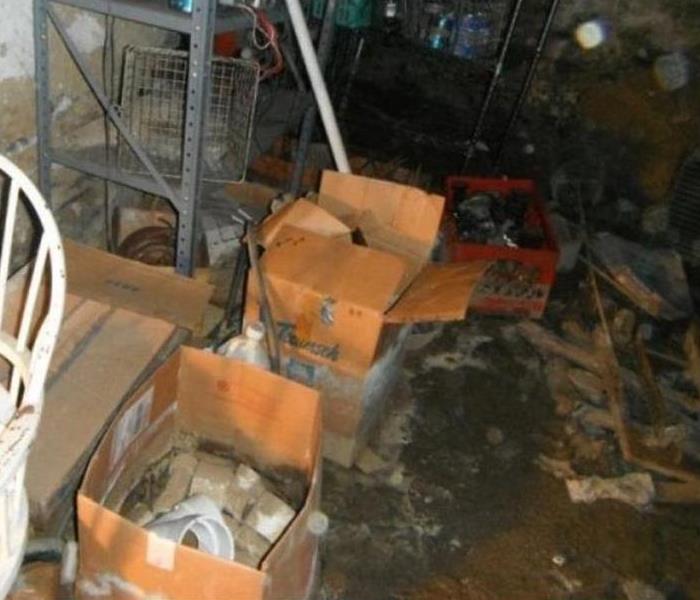 This flooded basement was caused by a local storm.
This flooded basement was caused by a local storm.
Six Indicators That You May Have Water Damage in Your Melbourne Residential Home
Six Indications That You May Have Water Damage On Your Property
Because water can flow to any region of your property, it's very important to be cognizant of signs that could indicate the presence of Melbourne water damage in your residential living space. Here are six important indications that water damage is present on your property:
1. Unpleasant Odors.
One sign that Melbourne water damage may be on your property is unpleasant odors. In many cases, hidden water can stagnate and then produce bacteria and mold growth. This growth results in the emergence of an unwanted musty odor.
2. Visual Signs Of Mold Growth.
In many cases, mold spores make their way into hidden spaces within the property owner's home structure. Water does, too. When the moisture comes in contact with the dormant spores, mold growth can take place. If you come across any fuzzy discolorations in isolated regions of your living space, be sure to have a mold remediation professional evaluate them.
3. Stains On Ceilings And Walls.
The water that gets into your wall voids often manifests in the form of a blotch or stain.
4. Peeling Paint.
Another sign of water damage in Melbourne is peeling paint on the wall's exterior. The drywall can saturate and cause your paint to lose its adhesion.
5. Sagging Ceilings And Walls.
Saturated ceiling and drywall materials can become quite heavy due to the added weight of water. After some time, these home structures will begin to buckle and deform. Water-laden ceilings and walls can pose several safety hazards if they collapse.
6. Floor Effects.
Water will constantly strive to move towards the lowest level and then seep beneath floor coverings such as vinyl, tile, and carpet. When this happens, the water will soak into your subfloor. In some cases, floor coverings like padding and carpet will have to be removed to dry the structure correctly.
If you note any of the signs above of water damage on your residential property, it's time to take action. The team to call for fast, effective water damage restoration services is SERVPRO. All of our IICRC-certified professionals offer a fast response, excellent customer service, and customized restoration modalities. Our deepest passion is restoring the client's property with skill and speed, and this is why we've become industry leaders with over 1,650 franchises.
Locally Owned Company with National Resources
As a locally owned and operated business, SERVPRO of West Brevard is strategically located to respond quickly to your flood and water emergency event. Call us today! 321-953-8600
Flooding and Water Damage in Palm Bay does more than Destroy Property
12/22/2021 (Permalink)
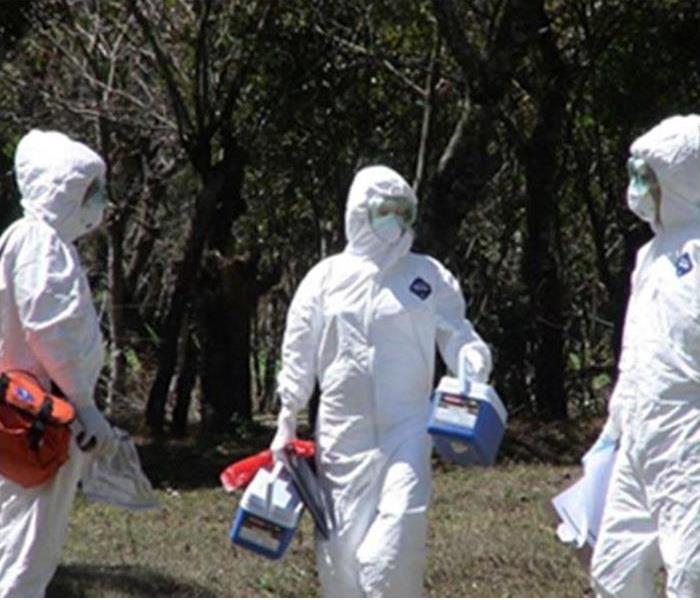 Mold can cause health effects.
Mold can cause health effects.
The Risks Associated with Flood and Water Damage in Melbourne.
Flooding and water damage in the Palm Bay area does more than destroy property; it creates an environment with numerous health risks. While anybody can be susceptible to these risks, certain segments of the population, like people with lung disease, children and the elderly, are at greatest risk.
Waterborne Dangers
Standing water is an ideal place for microorganisms, like bacteria, mold, and viruses, to breed. The chances of standing water becoming a breeding ground increases when the water damage contains toxins and sewage. The mold, viruses and bacteria created in this environment can become airborne.
The dangers are not eliminated after the flood water recedes, the contaminants still exist.
Dampness is another risk worthy of concern. The dampness of household items, furnishings and even the building can create an environment that encourages the growth of mold, dust mites, microorganisms and cockroaches.
Why Cleanup After a Flood is Important
Cleaning up after a flood or water damage should be a priority. The clean up process should also be handled with care. Any items that get cleaned must be cleaned properly. Throw away anything that cannot get cleaned or is damaged beyond repair.
Excess moisture after a flood or water damage negatively impacts indoor air quality. Because of this, flooded areas need a thorough cleaning as soon as possible. Here are a few of the problems caused by moisture:
- Environment becomes perfect for the reproduction and growth of microorganisms that could cause health problems.
- Long-term exposure to humidity is ideal for the population of dust mites.
Anyone involved with cleaning up after a flood or water damage should wear proper attire that includes masks and gloves. Coming into contact with many of these contaminants can cause illness.
The Cleanup Process
No one enjoys cleaning up after a flood or water damage, but its importance cannot be overestimated. Depending on the severity of the water damage, the cleaning process can be an arduous task. Here are the necessary steps of that need to be taken.
- Find the source of the leak and stop it.
- Figure out whose health could get affected
Make it a point to protect those who are most vulnerable to illness. This group will include the elderly, people with compromised immune systems, people with chronic illnesses and children.
- Determine the extent of the problem
This involves identifying all of the areas that are affected by flood water or water damage.
- Formulate a clean up plan
The plan needs to involve removing water damaged items and furniture while protecting those involved in the clean up process. Any items that can be salvaged should be cleaned. Those that cannot be cleaned should get thrown away. Any items that sat in water for 24 to 48 hours needs to get thrown away. Once everything is clean, do a final check to assess the thoroughness of the task. Throughout the process, make sure everyone involved is wearing protective gear.
It is important to not rely solely on air purification devices to get the job done. Proper cleaning and throwing away damaged items from water damage is the only way to clean after a flood.
SERVPRO of West Brevard proudly serves Melbourne, Satellite Beach, Melbourne Beach, Indialantic, Indian Harbour Beach, and surrounding areas. We are available 24 hours/7 days a week and are ready to restore damage to your home or commercial structure caused by:
- Water Damage
- Fire Damage
- Disaster, Storm, and Flood Damage
- Mold Damage
Categorization of Water Damage
11/18/2021 (Permalink)
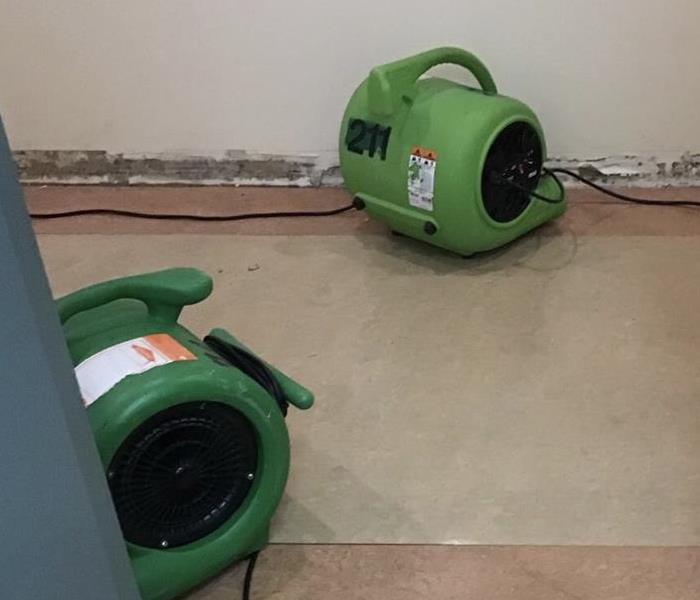 Drying floors and the walls is important for preventing more extensive damage.
Drying floors and the walls is important for preventing more extensive damage.
Every homeowner dreads the potentiality of water damage in his or her home. The risk of water damage increases after a heavy rain or when snow melts quickly. This problem can cost a homeowner thousands of dollars by damaging wood furniture, upholstery, electronics, household appliances, and plumbing equipment.
Significant water damage can also cause other problems in your home. For example, water damage will increase your risk of mold growth, which is very expensive to remedy.
If you do run into water damage problems in your home, it’s important that you quickly call SERVPRO to restore your home. SERVPRO will send experienced workers to your home that know the best ways to repair your damaged items and help with any water damage cleanup.
There are several issues that can cause water damage that would force you to acquire the services of a water restoration company. These include but are not limited to a leaky dishwasher, clogged toilets, broken pipes, broken dishwasher hoses, overflowing washing machine, leaky roof, plumbing leaks, and foundation cracks. In addition to water damage in your house, floods, heavy snow, and heavy rain can also lead to the collection of water in your basement.
If you do end up suffering from water damage, it’s very important that you address the problem immediately so the cleanup process can begin as soon as possible. Immediately beginning the process will significantly increase the likelihood of saving water-soaked furniture, carpets, rugs, clothing, and other items that might be damaged by the situation.
The Institute of Inspection Cleaning and Restoration Certification (IICRC) sets the standards for the cleaning industry and water damage restoration. They have placed water damage into three categories and four classes for liquid detection.
When you suffer water damage, the damage will be placed into one of three categories. These categories explain what type of water is causing the damage, how much of a threat the water causes to the health of humans, and potential causes of the damage.
Category one water damage is the least serious of the three categories. In this instance, you’re dealing with clean water, which doesn’t pose a threat to humans. The liquid in this category comes from appliances such as faucets, toilet tanks, and drinking fountains. So causes of category one water damage can be broken appliances or sink overflows.
Category two water damage is the appearance of gray water, contaminated water that contains microorganisms and may cause sickness if ingested by humans. Causes of category two water damage can be broken toilets, broken sump pumps, or seepage.
Category three water damage is the most serious case of water damage. In this category, black water makes an appearance. Black water is unsanitary as it contains bacteria and other organisms that can cause sickness or potentially death if ingested. Causes of category three water damage include sewage problems and contamination of standing water.
In addition to categories, water damage is also put in classes. These classes state how difficult the repair of the damage will be. Knowing the class of water damage is important for assessing the water damage repair options.
The least harmful form of damage is class one. This is the easiest damage to repair because it has a slow evaporation rate. In these cases, only part of a room was affected, little or no carpet has gotten wet, and the moisture only affects materials that have low permeance like plywood or concrete.
Class two water damage has a fast evaporation rate and affect an entire room. In this class, carpets and cushions have been saturated, moisture has accumulated on walls up to 12 inches, and moisture has collected in structural materials. Repairs of this type of damage are more difficult.
Class three water damage has the fastest evaporation rate. This type of damage involves the saturation of ceilings, walls, insulation, carpet, and sub-floors. In class three water damage situations, the liquid may have come from overhead as opposed to ground level.
The most difficult class of water damage to repair is class four. These situations require specialty drying because there has been enough liquid and time that it has saturated materials with very low permeance like hardwood, brick, and stone.
Suffering water damage to your home can be a difficult experience. If a situation occurs where your home is damaged by water, it’s important that you contact SERVPRO as soon as possible to fully restore your home.
Bathroom Supply Lines
4/16/2021 (Permalink)
When is It the Time to Replace a Supply Line in Your Bathroom?
Many of your household appliances that use water require a supply line. Because they are so commonly used, supply line damage can cause some major issues. It is important to call a professional as soon as you notice an issue. This can help prevent water build up in your home in Melbourne Beach, FL. Changing these lines when needed may actually help you avoid problems later on. How do you know when it's time to replace it though?
Check the Warranty
You may find that many of these hoses come with a warranty. It really just depends on what type you have. Most plastic lines come with a 5-8 year warranty. This means that you are responsible for replacing it if anything happens to it after that time is up. Steel braided ones often have a lifetime guarantee. While they are generally more expensive than the plastic ones, the benefits may be worth the extra cost. Always ask the seller about the warranty before you decide to purchase.
Watch for Damage
Supply line damage may lead to some pretty serious problems, such as standing water or mold growth. This is why it is a good idea to have a professional come out if you notice a supply line leak. Always shut off the water if you see an issue. This could be anything from a small bathroom leak to pretty serious flooding. Turning off the water can help prevent further damage from happening in your home.
If you are still unsure whether you have supply line damage, it is best to call a professional restoration company to come take a look. They may be able to help you resolve a number of issues that arise in this type of situation, such as fixing the leak and cleaning up the water. If your line gets replaced, always ask what type of warranty you are getting so that you will be aware if any future problems occur.
Homeowners Insurance & Water Damage Coverage
2/26/2021 (Permalink)
Does Homeowners Insurance Cover Water Damage?
Homeowners insurance is useful in times of an emergency. Insurance allows you to avoid having to pay out-of-pocket for expenses that are related to damage to your home. Submitting a claim after your home is damaged by water helps you recover money spent on repairs. However, it is important to know that there are positive and negative points to filing a water damage insurance claim has its good points and bad points.
Water Damage Coverage
Your insurance company covers certain types of water damage. In most instances, the insurance company will cover any damage that is the result of a sudden event. For example, if the broken dishwasher leaks water and causes any water damage, you are covered by your policy. But, any damage that results from a dishwasher that malfunctions because of inadequate maintenance or neglect will not get covered.
No Coverage
An issue that homeowners face that is not covered by a regular homeowner’s insurance policy is flood damage. If a local river overflows and floods your home, the flooding is not covered by your homeowner’s insurance policy. You will need to purchase a separate insurance policy to cover flooding. This type of insurance is advised for anyone living in an area prone to flooding.
Water damage is covered by homeowners insurance
Unfortunately, there are some limitations to this coverage. An accident that occurs suddenly will likely get covered. However, flood damage that arises from poor maintenance is not covered by your policy. It is important to know that you may find yourself disagreeing with your insurance company about the nature of your water damage. An incident that you believe is the result of a sudden accident may not get viewed as such by your insurer. Your insurance company may argue that the damage was caused by improper maintenance of your home.
If you need help with flood damage in West Melbourne. Please allow us to be of assistance, give us a call at (321) 953-8600.
Water Damage and Homeowner Insurance
12/3/2020 (Permalink)
Does Homeowner’s Insurance Cover Water Damage?
Homeowner's insurance is useful in times of an emergency. Insurance allows you to avoid having to pay out-of-pocket for expenses that are related to damage to your home. Submitting a claim after your home is damaged by water helps you recover money spent on repairs. However, it is important to know that there are positive and negative points to filing a water damage insurance claim has its good points and bad points.
Water Damage Coverage
Your insurance company covers certain types of water damage. In most instances, the insurance company will cover any damage that is the result of a sudden event. For example, if the broken dishwasher leaks water and causes any water damage, you are covered by your policy. But, any damage that results from a dishwasher that malfunctions because of inadequate maintenance or neglect will not get covered.
No Coverage
An issue that homeowners face that is not covered by a regular homeowner’s insurance policy is flood damage. If a local river overflows and floods your home, the flooding is not covered by your homeowner’s insurance policy. You will need to purchase a separate insurance policy to cover flooding. This type of insurance is advised for anyone living in an area prone to flooding.
Water damage is covered through homeowner’s insurance
Unfortunately, there are some limitations to this coverage. An accident that occurs suddenly will likely get covered. However, flood damage that arises from poor maintenance may not covered by your policy. It is important to know that you may find yourself disagreeing with your insurance company about the nature of your water damage. An incident that you believe is the result of a sudden accident may not get viewed as such by your insurer. Your insurance company may argue that the damage was caused by improper maintenance of your home.
If you need help with flood damage in Rockledge, FL call our teams of professionals at (321) 953-8600.
#waterdamage #homeownerinsuranceandwaterdamage #Rockledge #SatelliteBeach #SERVPROofWestBrevard
House Flooding
11/3/2020 (Permalink)
 Flooded kitchen floor due to pipe breaking.
Flooded kitchen floor due to pipe breaking.
Water flooding in your house, business, or place of work can happen at any time. Most of the reasons for flooding are due to pipes breaking, backed up septic tanks, water heaters. When those times happen we dry up the areas and think everything is dry and fine. But what most people do not realize is that moisture can be hidden behind walls, cabinets, and rugs.
Here are some facts:
- Mildew (mold in early stage) and molds grow on wood products, ceiling tiles, cardboard, wallpaper, carpets, drywall, fabric, plants, foods, insulation, decaying leaves, and other organic materials.
- Mold growths, or colonies, can start to grow on a damp surface within 24 to 48 hours.
- It is not always visible right after it happens, meaning if you do not get a rapid response on the matter it will grow.
- Even if you dry the area it can be wet behind walls.
- Bleach does not stop the growth behind the walls.
What To Do After Flooding
- Turn off electric to the affected area.
- Call SERVPRO of West Brevard!
- Remove excess water by mopping and blotting.
- Wipe excess water from wood furniture after the removal of lamps and tabletop items.
- Remove and prop wet upholstery and cushions.
- Place aluminum foil or wood blocks between furniture legs and wet carpeting.
- Open exterior doors and windows.
- Remove colored rugs from wet carpeting.
- Remove art objects to a safe, dry place.
- Gather loose items from floors.
What NOT To Do After Flooding
- Don't leave wet fabrics in place. Hang furs and leather goods.
- Don't leave books, magazines, or other colored items on wet carpet or floors.
- Don't use your household vacuum to remove water.
- Don't use television or other household appliances.
- Don't turn on ceiling fixtures if the ceiling is wet, and keep out of rooms where ceilings are sagging.
#waterfloodinginhouse #waterdamage #SERVPROofWestBrevard
Flooding and Why Time is Important
10/12/2020 (Permalink)
Many of us have experienced a leaky pipe, storm damage, backed up toilet, overflowed tub, and even septic back up. When a flood happens we rush to dry up the floor and clean the area. But what most do know is the moisture can cause mold to start growing. Did you know that mildew and mold will develop within 24-48 hours of water exposure?
Here are some important tips when floods happen.
- Take photos of the flooded area from the outside area
- Shut off electric to the area flooded ( do not enter a flooded room with electric on )
- Try to dry most of it if possible
- CALL our offices at 321-953-8600
SERVPRO of West Brevard will make it feel "Like it never even happened."
Does a flood mean new carpet?
9/2/2020 (Permalink)
 Extracting water from affected carpet.
Extracting water from affected carpet.
Can my carpet be saved after water damage?
When you have a pipe break and an unexpected flood in your home, one of the biggest concerns is the damage to your floors, walls, and possessions. It behooves you to save as much as you can. It's not just economically sound, but environmentally smart, too. When your carpet gets soaked, can it be saved? The good news is that it often can be cleaned and kept. Consider the following factors:
- What is the source of the flooding water? If the water is non-contaminated or is grey water, the rug can be cleaned and used again. Grey water includes water from washing machines, dishwashers, bathtub or shower overflow, and toilet water with urine only.
- How long has the flooring been wet? Clean water becomes grey water after 24-48 hours, and grey water becomes black water after 24-48 hours. Black water is a source of fungus, bacteria, and other pathogens. Flooring saturated with black water must be replaced.
- Does the water have minimal contaminants? Water from a pipe break, hot water heater failure, or overflow from bathroom, kitchen, and utility sinks is considered clean water. Carpets soaked with this type of water can be cleaned and dried. The pads can also undergo a full restoration.
In instances where the water is grey, approaching black, it is advisable to clean the rug but replace the pad.
Be Aware of These Contaminants
There are some contaminants that are too toxic to mess around with. If your flooring is exposed to the following, you will need a full replacement:
- Water from sewage or storm drain backup
- Water with fecal matter, vomit, or other biological contaminants
- Water with heavy metals or chemicals
If you have a pipe break with significant flooding, let the professionals in Palm Shores, FL asses your flooring damage. A restoration and cleanup crew will make your home look "Like it never even happened."
Keeping your Business Safe from Water Damage
4/16/2020 (Permalink)
 A pipe break could expel large amounts of water into your facility which could result in significant flooding.
A pipe break could expel large amounts of water into your facility which could result in significant flooding.
As a business leader, you’ve got enough to worry about with your day-to-day operations that you don’t want to think about problems with your facility. However, it’s not uncommon for Viera, FL, companies to contend with leaking pipes or other matters that can lead to flooding and water damage. It’s important to identify the causes of these potential disasters and troubling incidents so you can prevent them and more effectively clean them up.
Potential Hazards
In some cases, something such as a toilet backup or a slow leak in a pipe will only cause minor concerns in a bathroom or break room. However, if these things go undetected, you could face significant financial consequences or even potential interruptions to your business.
- Flooding could damage or ruin the carpet, drywall, ceiling tile, furniture or electronics.
- Water damage could create an unsafe environment for employees.
- Water damage may not be covered by your insurance.
The Gradual Issues
Leaking pipes could drip water onto floors or into the walls of your office over a long period of time without you even realizing it. Over the course of months or even years, this can rot away the drywall or subfloor. This problem could even encourage the growth of mold or other fungal development.
A Sudden Rush
If your building is aging, you may need to take a look at the plumbing system and make sure the pipes are still in good shape. A pipe break could expel large amounts of water into your facility, which could result in significant flooding. Even if you react quickly to this incident, you could still face heavy costs and loss of equipment and supplies.
Mother Nature
A weak roof or poor foundation could be vulnerable if heavy rain hit during a thunderstorm. Leaking pipes will put water on your floor slowly, but severe weather could inundate you with too much to handle.
If any of these events occur in your building, you know where to turn. Contact a commercial water damage specialist immediately.
Protecting Wood from Water Damage
2/24/2020 (Permalink)
Most houses have wood integrated into their structures in some way or another. Often these wooden parts of the house are used for decks, doors, or garage doors. The problem with wood that is open to the elements is that water damage is always a possibility. Similar to issues with the foundation, if gutters are absent from the building or are defective so that water flows straight down rather than being directed away from the building, the result could be rotting, mold growth, or other problems associated with wood being affected by water.
Keep Outside of the House Clean
When rainwater flows off the roof, it brings with it the mud, sand, and other debris that may have collected on the roof. What fell from the sky as clean water is now dirty water that can leave a trail on the house. The result of this could be the staining of doors, windows, and siding which could negatively affect the look of the house and force you to clean the house more frequently. The primary purpose of gutters is to direct water away from the house so that the water doesn’t flow straight down where it can cause trouble.
By doing this, the water that would have caused these unsightly features will now be directed well away from the house leaving the home with a cleaner outside look.
How to Handle Water Leaks and Floods in Your Satellite Beach Home
12/11/2019 (Permalink)
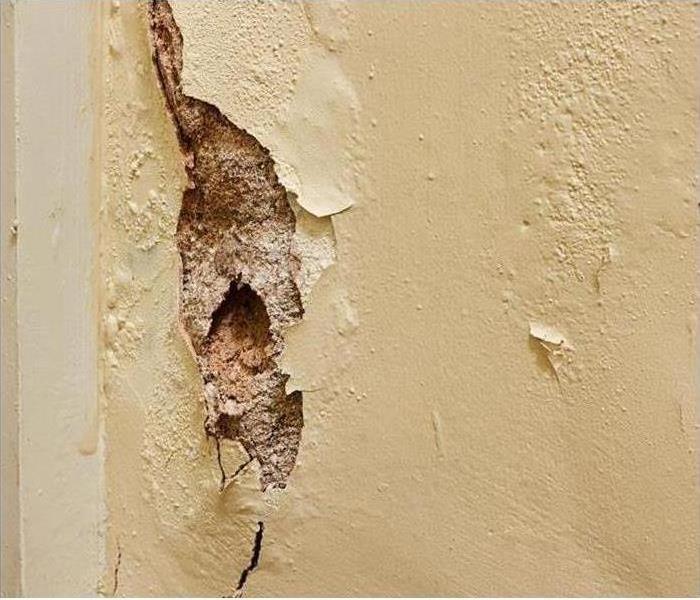 Water can easily destroy the walls, floors and structure of your house.
Water can easily destroy the walls, floors and structure of your house.
West Brevard water damage can be a problem if there is a leak or flood in your home. Water can easily destroy the walls, floors and structure of your house. It can cause dangerous mold to grow. It can ruin personal possessions and appliances. You should know what to do when faced with a water leak or flood.
Try To Stop the Leak
The first step is to try to stop the leak. Find the source of the water. If there are shutoff valves nearby, then turn them off to stop the flow of water. Alternately, you could turn off the water mains to the entire house. If neither of these steps is an option, then you may be able to seal off the source of the leak with duct tape, rags or other materials. Attempt to do this only if you can walk safely through the water.
Stop the Water from Spreading
If your home is flooding, then try to stop the water from spreading. You can use sandbags, towels or other items to create a barrier that the water cannot pass through. This will help even if you can just slow the water down a little from freely flowing into your home. You could also attempt to put down towels if the water is very shallow. This will help to limit the amount of West Brevard water damage.
Get Your Possessions off The Ground
If you have possessions on the ground where the water is leaking, then pick them up. Pick up rugs, furniture and anything else. You do not want the water to destroy those items. Additionally, porous items like paper, fabrics or wood can become sources of mold after the water stops leaking. Put your items somewhere high up so that they are not in danger. Hang up any wet or soaked items to dry if possible.
Contact a Restoration Service
You should contact a restoration service like SERVPRO as soon as you realize that there is a leak and have stabilized the situation. These professionals will come into your home, remove the water and start dealing with the damage. They can dry out you floors, walls, and some personal possessions. They can also remove damaged parts of the home that are not salvageable. Restoration services are critical for recovering from water leaks or floods.
Take Preventative Action
You want to take some preventative action after the restoration company has finished. You want to inspect your plumbing regularly. You also want to check and maintain your appliances. Make an effort to have your roof checked for damage on an annual basis. Keep the number for the restoration company handy just in case. These steps will reduce the chance that you will have to deal with serious Satellite Beach water damage again in the future.
Locally Owned Company with National Resources
SERVPRO of West Brevard is locally owned and operated, so we are part of this community too. When you have a flooding or water emergency, we’re already nearby and ready to help. We take pride in being a part of the Viera, FL community and want to do our part in making it the best it can be.
We proudly serve:
Water Damage Satellite Beach, FL
and surrounding areas.
Does Homeowners Insurance Cover Floods and Water Damage
11/25/2019 (Permalink)
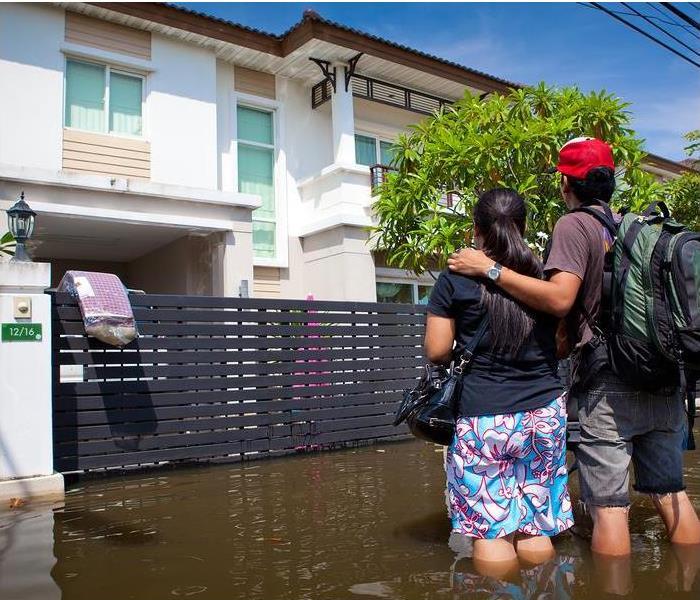 Your insurance company only covers certain types of water damage.
Your insurance company only covers certain types of water damage.
Home insurance is useful in times of an emergency. Insurance allows you to avoid having to pay out-of-pocket for expenses that are related to damage to your West Bevard, FL home. Submitting a claim after your home is damaged by water helps you recover money spent on repairs. However, it is important to know that there are positive and negative points to filing a water damage insurance claim has its good points and bad points.
The Positive Points
Your insurance company covers certain types of water damage. In most instances, the insurance company will cover any damage that is the result of a sudden event. For example, if the broken dishwasher leaks water and causes any water damage, you are covered by your policy. However, any damage that results from a dishwasher that malfunctions as a result of inadequate maintenance or neglect will not get covered.
Another example of water damage covered by your insurance policy, damage caused by a pipe bursting suddenly. Insurance companies will cover a water damage claim if the pipe burst was caused by the temperature dropping below freezing.
The Negative Points
Insurance companies will not cover water damage that is the result of improper maintenance. This type of damage occurs gradually over a period of time and is avoidable when homeowners engage in regular home maintenance. An example of this would be a claim that is filed to cover damage caused by a bursting pipe. The claim will not get covered if the pipe’s bursting was the result of a rapid decrease in temperature that resulted from an improperly heated home.
Another issue that homeowners face that is not covered by a regular home insurance policy is flood damage. If a local river overflows and floods your home, the flooding is not covered by your homeowner’s insurance policy. You will need to purchase a separate insurance policy to cover flooding. This type of insurance is advised for anyone living in an area prone to flooding.
Water damage is covered by homeowner’s insurance. Unfortunately, there are some limitations to this coverage. An accident that occurs suddenly will likely get covered. However, flood damage that arises from poor maintenance is not covered by your policy. It is important to know that you may find yourself disagreeing with your insurance company about the nature of your water damage. An incident that you believe is the result of a sudden accident may not get viewed as such by your insurer. Your insurance company may argue that the damage was caused by improper maintenance of your home.
If you need help with flood damage in Melbourne, Satellite Beach, Melbourne Beach, Indialantic, Indian Harbour Beach, West Brevard, Palm Bay, Viera, West Melbourne, Malabar. Please alow us to be of assistance, give us a call at (321) 953-8600.
Will Your Roof Of Your West Brevard Home Cost You Thousands This Winter
11/20/2019 (Permalink)
While there are many things that homeowners in Viera must do to keep their living space in exceptional condition, tending to the roof is one of the most important. In the event that your roof becomes susceptible to damage due to neglect or maintenance oversights, you could wind up paying thousands of dollars for water damage restoration. And while it's a good idea for you to ensure that your home in Palm Suntree remains as aesthetically appealing and functional as possible, it's also prudent to avoid spending a great deal of money accomplishing this objective. By learning more about how roof damage and water damage is caused, you can prepare yourself to keep your money in your wallet rather than spending it on repair services.
Getting To The Root Of Roof/Water Damage
There are several factors that can cause your roof in Palm Shores to become susceptible to damage, and one of them includes a flat roof. If you have a flat roof, you should know that this could be the source of the problem. Why? Because a flat roof with a freezing drain pipe will trap water. Once this water begins to accumulate, it can generate water leaks which can lead to water damage in your Cocoa home. If this happens, it may become necessary to remove the downspout and then open the drain in order to create discharge.
Another challenge that can result in roof damage of your home in Merritt Island is the natural elements. For example, ice accumulation and snowfall can increase the amount of weight and pressure on one's roof. The solution to this issue is simple: take the time to remove the unwanted ice and snow from your roof. There are several other issues that can precipitate roof damage, including ice in your gutters.
Preventing Roof Problems Before They Start
While it's important to be informed about various issues that can result in water damage, it's even more important that you prevent the problem from happening in your Cocoa Beach home. And how can this objective be accomplished? By utilizing high-quality roof maintenance services. Roof maintenance services are important and advantageous because they enable professional inspectors to quickly identify any potential problems with your roof and subsequently eliminate the issue before the molehill evolves into a mountain. In order to ensure that you get high-quality roof maintenance services look for the following things in the company:
- Qualifications/Credentials
The roof maintenance company that you in Patrick Air Force Base hire should possess substantive qualifications and credentials indicating their ability to do an excellent job. Some qualifications you should look include education, experience in the field, and any awards a company or its employee may have won for offering outstanding service.
- Good Reviews
A good roof maintenance company in Rockledge will have good reviews from former customers who have used their services. As a result of the fact that we live in the Information Age, you can easily go online and read reviews that customers have left on the company's website or other social media forums.
- Money Back Guarantee
Excellent, expedient roofing companies in Melbourne will typically be confident enough in the quality of their services to offer a money back guarantee. The guarantee can include anything from a warranty to a 100% full refund for any services you're not thoroughly satisfied with.
Conclusion
As the winter approaches, you are likely becoming excited about spending time with family and friends in your West Melbourne home as you enjoy the upcoming holidays together. To ensure that you get the most out of the season, make sure that you're keeping your roof impervious to damage from the natural elements and other issues that can precipitate problems. By following the brief outline offered above, you can accomplish this objective without hassle and inconvenience. Good luck.
Black Water Damage Restoration
11/18/2019 (Permalink)
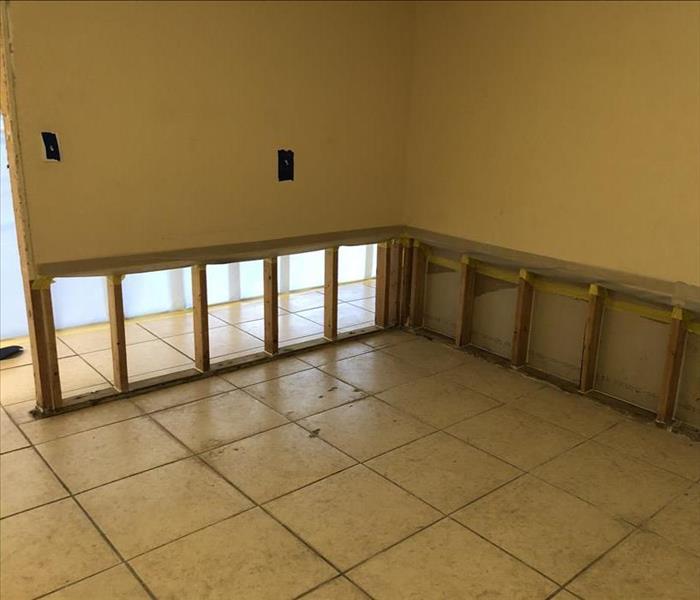 When floodwater has different contaminating agents, as well as virus that can present severe health risks, it is referred to as "black water."
When floodwater has different contaminating agents, as well as virus that can present severe health risks, it is referred to as "black water."
Black Water Damage Restoration in your Suntree Home
When floodwater has different contaminating agents, as well as virus that can present severe health risks, it is referred to as "black water." In many areas of the United States, flooding is a serious risk, and black water contamination in Suntree is always possible.
Storms, hurricanes, and excessive rains can all contribute to floods by leading to rising water from natural bodies of water and causing sewage back-flows. If you want to remediate Viera black water contamination that is present in a building, it is best to contact SERVPRO. The task will necessitate a great deal of planning, and specialized equipment. Our licensed professionals will have the expertise to assess the situation, as well as clean and dry the necessary locations.
The following is a list of steps that should be followed in the case of black water damage:
1. Make sure that all building workers and other occupants are safe. Anyone who is working will need to don protective equipment, such as eye protection, boots, gloves, respirators, and waterproof coveralls.
2. The contractor who was hired must thoroughly inspect all of the affected areas to be able to assess the seriousness and nature of any damage, which will have an impact on the remainder of the restoration process.
3. Excess Viera water needs to be removed as quickly as possible, in order to prevent any further damage. It is also important to remove sewage, contaminated porous materials, and any other waste. Negative air machines, air scrubbers, and other specialized tools may need to be utilized to stop the contamination from spreading. EPA-approved disinfectants will be used on affected surfaces.
4. Once the contractor has finished sanitizing, a balanced drying system will be put into place to restore damaged areas to their former conditions.
Specialized procedures will be used here, as well as specialized equipment and products, including high capacity air movers and professional dehumidifiers. In all situations of property damage, including that of black water contamination, contact the SERVPRO of West Brevard office. Our professionals will provide services to restore properties after disasters and minimize the overall losses.
3 Steps for Dealing with a Leak
10/16/2019 (Permalink)
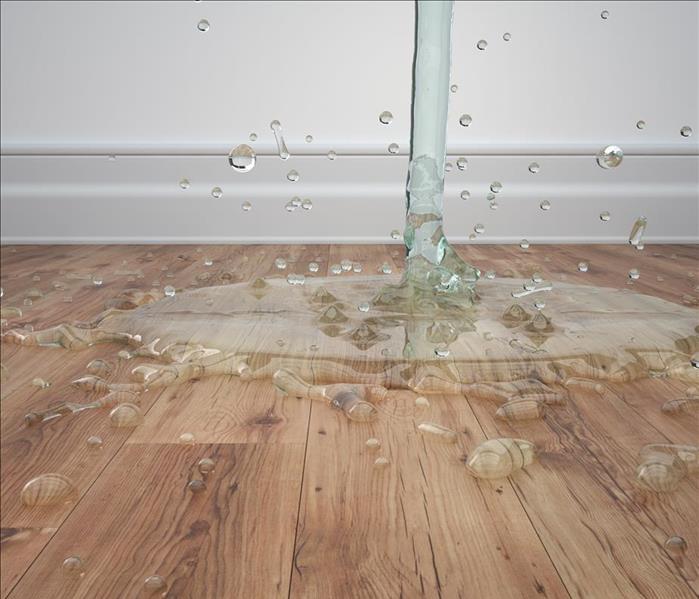 Water leaking in a June Park, FL home
Water leaking in a June Park, FL home
3 Steps for Dealing with a Leak
No matter how well you take care of your home in June Park, FL, the unexpected can happen. When the unexpected comes in the form of flooding or a massive leak means water in home, addressing the issue quickly can be the difference from a quick cleanup or damage that spreads beyond the water infiltration. Below are three vital steps in keeping damage to a minimum.
1. Shut the Water Off
While you can’t turn off flooding, if faced with a pipe burst, the main water source to the home needs to be turned off. This is especially important considering that although you may see the water, the actual source of the problem is likely hidden behind the walls. If it is visibly coming from under a sink, and you are certain there isn’t a bigger problem, it can be turned off directly at the source.
2. Call Your Home Insurance Provider
Once the water has stopped, contacting your insurance provider is important. While a small leak may not result in a claim, extensive damage needs to be immediately assessed. Along with the visible damage, water can create additional issues such as mold in the walls. If there is extensive damage, your insurer may provide additional benefits during the repair process. It’s also important to understand what kind of coverage you have. In the case of natural flooding, this typically requires an additional policy.
3. Find a Reputable Restoration Company
While some leaks may require a simple kitchen repair, severe damage can quickly spread. Contacting a professional can help ensure that fast action is taken to get your home cleaned, dried and repaired before secondary damage happens. Finding a company that is certified in these kinds of repairs provides peace of mind that they have the right tools and expertise.
At the first signs of water trouble, taking these few steps are imperative. Along with minimizing damage, it can help make the process easier.
Rockledge Residents: Water Damages Should be Treated Immediately
7/16/2018 (Permalink)
 Faster to Any Size Disaster!
Faster to Any Size Disaster!
SERVPRO: Your First Choice For Professional Water Damage Restoration Services for Your Palm Shores Home
When your residential Rockledge property is subjected to water damage, dealing with the aftermath that results can be irritating and economically taxing. Additionally, individuals who do not address the water damage aftermath immediately will often find themselves grappling with even more expenses and emotional turmoil. To ensure that your water damage issues are addressed and resolved with expedience and efficacy, we suggest that you trust the professional technicians of SERVPRO. Learn more about water damage and how we can help you eliminate it by reading this short guide:
Water Damage: A Brief Overview
Water damage can be a severe problem that can result from varying sources. In many cases, water damage results from natural disasters like floods, fires, earthquakes, tornadoes, and hurricanes. Additionally, water damage can be caused by a broken sewer line or a leaky faucet. Each of these situations is unique and necessitates the use of highly specific water damage restoration services. Although some situations can be resolved more easily than others, any event involving water damage constitutes an emergency. This is the case because water damage that is not addressed immediately can entail structural issues on your property as well as potential health effects resulting from mold growth.
Why You Should Avoid DIY Clean Up and Repairs
In many cases, residential property owners in Brevard want to complete the water damage process on their own. These DIY projects are not a good idea for several reasons. First, most people do not have access to the specialized equipment that water damage restoration experts use to optimize and expedite the cleanup and drying processes. Additionally, water damage restoration can involve exposure to hazardous materials such as blackwater, dangerously contaminated water, and mold. Industry professionals are trained to address these issues without exposing themselves to danger, but most residential and commercial property owners have not undergone this type of training.
How SERVPRO Can Assist You
As an industry leader with more than 57 years of experience in offering water damage restoration services, SERVPRO's technicians can provide you with the most advanced, accelerated remediation assistance. All of our technicians have obtained IICRC certification and, therefore, can quickly and correctly resolve any aspects of water damage issues affecting your house. One of the reasons that we're the best company to call is that we offer 24-hour emergency services. Irrespective of the time that you take note of water damage on your property call us. We'll provide you with the immediate response necessary to quickly address and commence with water extraction and follow through with our time-tested protocol through to the end of the restoration.
Not Home For the Holidays
12/22/2017 (Permalink)
 Are you traveling during the holidays and not going to be home? Use these 5 tips to protect your home while you're away.
Are you traveling during the holidays and not going to be home? Use these 5 tips to protect your home while you're away.
Spending quality time with your families may be one of the best parts of the holiday season. For many of us, we live in another city or state than our family. Which means start packing up and get the family ready to head out. Before you leave, it’s important take the proper precautions to keep your house safe while you’re away.
The holidays can be the most wonderful time of the year, as long as you take the steps needed to protect your house for when you return.
Turn Down your Thermostat
Not only will you save money on your electricity or gas bill by turning off the heat or AC, but you limit your chances of an AC leak or furnace malfunction while you’re away from you home.
Notify a Neighbor
Be sure to notify a trusted neighbor. Ask the neighbor to keep an eye on your house and report any suspicious activity. You’ll also want this neighbor to keep your walks cleared of snow and to pick up your mail and newspapers while you are away. Make sure your house looks like somebody is home to deter a burglar.
Check your Holiday Lights for Fraying or Damage
December is the deadliest month for electrical fires. Before you string lights on the house or the tree, be sure to inspect the strands to make sure there aren’t any frayed cords or cracked lamps. Replace any broken lamps and throw away strands with frayed cords. This will help prevent any accidental fires.
Inspect the Furnace & the Chimney
Heating-equipment, like furnaces and fires can cause many deaths every year in the United States. In fact, in 2008, the U.S. Fire Administration reported approximately 2,650 people were killed by house fires. Take the time to have a professional come inspect your furnace and clean the chimney before you need to heat your home.
Turn Off your Water
By turning off your water, it ensures that you won’t come home to water damage. Appliances malfunction when you least expect it and if the water is turned off there is no chance your water heater or pipes will leak.
Locally Owned, with National Resources
SERVPRO of West Brevard is locally owned and operated so we are part of Viera and Rockledge, Florida community too. When you have a fire, flooding or water emergency, we’re already nearby and ready to help. As fire and water damage specialists, we have the experience, the expertise, and the advanced training that enables us to get your property restored quickly and thoroughly. Please call (321) 953-8600.
What You Should Know About Water Damage
12/29/2016 (Permalink)
Water damage can be a very difficult situation for any homeowner. But there are certain tips that can help save you time and money. There are also things you shouldn’t do as it can make the situation worse. Here are some tips to guide you in dealing with water damage in your home.
Do not open the windows
It may seem like instinct to immediately open up any and all windows when you first discover unexpected moisture, but that could actually make matters worse. You want to avoid any excess heat and humidity in order to not complicate the drying process. Instead, call SERVPRO immediately so that the moisture can be examined and removed right away. It is also wise to pull any wet materials or furniture away from the water so that they do not become damaged. Keeping the windows closed will allow the air system to run as it usually does and maintain a stable environment for proper drying.
Your insurance company needs to know right away
When water damage occurs, the best method of defense is calling SERVPRO immediately to schedule an inspection and begin the treatment process. It is also extremely important that the next phone call you make is to your insurance company to get more information on if and what they will cover. Your insurance agent can guide you through the process and help protect your property from further damage. This is important information that can impact the value of your property if it is not addressed immediately and correctly.
Not all water damage is covered by insurance
There are different insurance policies for flood damage and water damage, so not all water damage is created equal. These are things your insurance agent will have questions about and need as much information as possible in order to report a claim. Make sure to specify where the water came from and how much there is so that your insurance company can work with you to handle the situation the best way possible. Most policies cover things like sudden damage such as an overflowing washing machine or a storm, but situations caused by neglect or carelessness are not typically covered by insurance. It is also important to know if you have a separate policy through the National Flood Insurance Policy so that your insurance company can adjust your claim appropriately.
Where the water came from matters
Not only does where the water came from matter for repairs, it matters because the water may be polluted. Water alone can be extremely damaging if it is not dealt with immediately, and if there are any chemicals or bacteria in it can speed up the damaging process and even cause illness. There is a 24 to 48 hour window from the time that water is exposed to an area and the time that mold begins to grow. Mold multiplies quickly and can be extremely dangerous to the health of anyone around it so it is vital that it does not have the opportunity to spread within the water.
Standing water breeds bacteria so that means that any contamination the water touches is spreading germs and can worsen the contamination of your property the longer it is there. The worse the contamination becomes, the more extensive the cleaning process becomes. It is important to address the situation immediately so the water does not breed any bacteria and is removed before further damage occurs.
What not to do
Beyond keeping windows shut and calling SERVPRO and your insurance company, there are several other things you should not do in the case of water damage. Do not leave wet fabrics in the standing water or they will be ruined. Also, do not leave any books or magazines on wet carpets or floors. Avoid turning on any televisions or household appliances that may have been exposed to the standing water as a safety precaution. No matter how tempting it may be, leave the water removal process to the professionals and do not use your household vacuum to remove the water yourself.
SERVPRO can remove water and prevent damage
When unwanted moisture accumulates, the highly trained technicians at SERVPRO use advanced water damage inspection and extraction equipment to find and remove it as quickly as possible. The water damage experts will monitor and document the drying process so that you know your property is back to normal. SERVPRO is a trusted leader in the water restoration industry and is able to take on water damage incidents of all types, including storm damage, mold remediation, sewage cleanup, and commercial water damage.
Avoiding Water Damage Caused by Runoff
12/16/2016 (Permalink)
Whenever it rains on your home, runoff will occur. All homes are specifically designed to deal with this runoff so that it doesn’t negatively affect the home. If the water runoff from the roof is not properly handled, it can cause serious problems for the home such as putting into question the stability of the structure or causing water damage to the inside and outside of the home. These are some of the ways that water runoff is dealt with in homes.
Problems Caused by Runoff
The biggest problem that can be caused by water runoff is the structural integrity of the building. If a large amount of water collects near the building’s foundation, it can get absorbed into the soil and can put enough pressure on the foundation that it can cause it to break. Additionally, if a significant amount of water runs down the side of the building, it can wear away at the siding, walls, and the foundation.
Another problem that can occur from a large amount of runoff is that large sections of the landscaping can quickly erode. If this problem occurs, soil and plants can be stripped away and damage can be caused to adjacent aspects of the home such as driveways and sidewalks.
Gutters as a Defense
The first line of defense when it comes to water runoff from the roof are the gutters. Lining the entirety of the house, the sole purpose of the gutters is to collect the water that comes off the roof and direct it far away from the house so that it doesn’t cause any damage to the side of the house or the foundation. Due to the significant impact that gutters have on directing runoff away from the structure, properly maintaining your gutters are crucial to protecting your home from water damage. Gutters often collect leaves and other debris so regularly cleaning the gutters to ensure that there are no blockages is a simple maintenance task that will go a long way to avoiding water damage.
Landscape Drainage
The sole purpose of landscape drainage is to collect the water that comes out of the gutters and redirecting this excess water away so it doesn’t damage your landscape. A very common way of setting up landscape drainage is by using gravel and underground drain pipes. Gravel is strong enough that it can hold up the ground while featuring enough space to allow water to flow through it and into the pipes below. Once the water flows down into the drain pipes, it is directed to a drain field that is located far from the house.
Foundation Drainage
The purpose of a foundation drainage system is to protect your foundation if a large quantity of water accumulates near it. If installing a foundation drainage system is necessary, it will be set up right next to the foundation and will feature layers of gravel and drain pipe. Unlike landscape drainage systems, which are near the surface of the landscape, a foundation drainage system gets buried down at the bottom of the foundation walls. If large quantities of water accumulate around the foundation, the system will redirect as much water as possible away from the foundation to avoid any potential damage.
Foundation Waterproofing
A way to keep your foundation safe from any potential runoff that may direct water toward the foundation is through foundation waterproofing. If this is the right course of action for your home, the exterior of the foundation will be coated with a waterproofing membrane which will provide extra protection from water. The process of installing this waterproofing involves excavation next to the foundation which is done to ensure that all sides of the foundation are covered by the application. The membrane then forms a seamless waterproof barrier around the entirety of the foundation.
Runoff from the roof of a house has the potential to cause significant damage to the home if it is not properly dealt with. To avoid any of these potential problems from occurring, gutters direct water away from the home and drainage systems are often installed to protect landscaping and the building’s foundation from becoming damaged. If water damage does occur to your home, call on the professionals at SERVPRO to restore the home.
Common Issues with Gutters
11/30/2016 (Permalink)
When water gets into the foundation of your home, it has the potential to cause structural issues to the home. The result of a wet foundation can also be windows and doors sticking to their frames. Gutters are installed on houses and connected to downspouts precisely to avoid this problem. These systems are essential in protecting the structure and integrity of your home. But, in order for these systems to work, you will need to ensure that these systems are free from clogs, holes, and sags.
Clogged Gutters
The most common problem that tends to occur with gutters are clogs caused by debris. The additional weight that is caused due to the accumulation of leaves, twigs, and standing water will cause the gutters to sag and pull away from the house. To avoid such a situation, you should clean your gutters at least once each year, twice if you have trees hanging over your gutters. Once the gutters are free of debris, you should use a hose to spray the gutters to make sure that the water is flowing as it should. Another option to consider are gutter covers. These cover the gutters from above featuring mesh screens, clip-on grates, and porous foam but still require regular maintenance.
Sagging Gutters That Pull Away from the House
If your gutters are sagging or starting to pull away from the house, the problem more than likely has to do with the hangers. The gutter hangers are the metal pieces of the system that secure the gutters to the fascia. They are easily noticeable as they stretch across the inside of the gutter. Over time, normal wear and tear may have caused these hangers to deteriorate. Other issues with the hangers may be that the fasteners may be detaching from the wood or that they are spaced too far apart so that they can no longer support the full weight of the gutters.
Damage to the Gutters
If your gutters have suffered damage, they may be leaking or have holes in them. If the issue is a leaky gutter joint, the issue can be solved by sealing the joint with caulking from the inside with gutter sealant. Likewise, any holes that are very small should be able to be sealed with gutter sealant. Big holes, however, will require a patch to be fixed.
Poorly Sloped Gutters
A common problem with gutters are that the gutters are not sloped down toward the downspouts. This means that the water cannot flow freely to the downspouts and down to the ground. To ensure that your gutters are properly sloped, you should have at least a quarter inch slope for every ten feet. If you have a rainstorm and there is standing water in your gutters following the storm without clogged gutters being an issue, your gutters are not sloped correctly. The proper course of action is to ensure that the gutters are sloped correctly to the downspout to ensure that the water can properly flow down to the ground and away from the house.
Water Draining Toward Foundation
For the downspouts to be effective, they should extend several feet away from the house. If the downspouts are located too close to the house, water can collect at the foundation. If the water drains into the foundation, serious issues to the home such as structural problems or windows and doors sticking to their frames could be caused. If your downspouts are draining too close to the foundation, consider installing gutter extensions to the bottom of the downspouts. This will ensure that the water drains away from the house far enough that it doesn’t cause any damage to the foundation of the home.
Gutters are an essential part of keeping water damage from effecting your home. When rainwater collects in the gutters or runs off the roof, the gutters drain the water into the downspouts which flow the water far away from the home and its foundation. Issues such as clogged gutters or sagging gutters could cause water to build up and damage the gutters. If the downspouts do not direct the water far enough from the home, it could infiltrate the foundation causing serious and expensive damage to the home. If you suffer from water damage in your home, call on the professionals at SERVPRO.
Maintaining Home Value After Water Damage
11/11/2016 (Permalink)
Your home is one of the biggest investments of your lifetime. It is where you rest, play, spend time with family, it is your own retreat away from the hustle and bustle from the busy world. Protecting your home is the first step in valuing it for the importance piece of your life that it is. Prevention and repair are key to maintaining a home that will retain its worth and continue to be a haven for you and your family. That means that if any damage occurs in your home, it is crucial to address it immediately in order to conserve the value.
As a homeowner, it is of the utmost importance that damage of any form, water, fire, mold, or storm be made a top priority. Even if it appears that there is only a small amount of damage, the reality is that damage only gets worse as time goes on. Taking action and having the area inspected as quickly as possible usually results in a much simpler and more cost friendly repair than if the damage has time to grow. Repairing damage quickly also guarantees that the cost value of your home is not negatively effective and can still remain a positive investment in your life and your wallet.
When damage occurs, the first thing to do is call SERVPRO and get in touch with a 24-7 technician. SERVPRO is available all day, every day to assure that no damage goes unrepaired. Help will be on the way as soon as your call is placed and a highly trained specialist will be on the scene ready to begin the inspection process. Everything from water removal, and carpet cleaning to television repair falls under the SERVPRO cleanup and restoration umbrella and is executed by the best in the industry.
Here are just a few reasons why calling SERVPRO to repair damage immediately is so beneficial to the overall value of your home and property:
Selling Your Home in the Future
If you plan on selling your home at any point, you definitely want to get the most out of your sale. It is not possible to sell a home for the same amount or more of the purchase price if damage of any kind has occurred and was not addressed properly.
It is required that the fact any water or fire damage occurred to the home or property be disclosed before the purchase of your home is made. So if the damage was not repaired properly, it will definitely be noticed. On top of that, homes must pass inspection before the purchase is made as well. If the repaired damage does not pass the inspection, that could mean your home may not sell for the price it is listed as.
Refinancing Your Home Down the Road
When refinancing your home, it must be inspected and reported on by an appraiser. If any damage has occurred and not dealt with, your home will lose dollar value and be considered less valuable than the original price you bought it for. The whole point of refinancing is to end up spending less money on your home and that simply is not possible if damage occurs and is noticed.
Damage Only Gets Worse if Not Treated
They say everything gets better with time, but that is not the case for homes if they are not maintained. When damage occurs, it only gets stronger with time. Call SERVPRO immediately so that the damage does not increase and end up burning a hole in your pocket. SERVPRO not only helps with damage of the actual home, but also helps care for your belongings. That means that your home can quickly be restored with attention to detail of everything within the damaged area.
When big money is spent on something so important as a home for you and your family, it is absolutely worth it to respect the large investment and maintain the quality of the purchase. Repairing water, fire, or storm damage immediately with the help of SERVPRO gives you peace of mind that your home will not lose its value and continue to be the investment of a lifetime.
4 Reasons Why Water Damage Requires Professional Restoration
10/10/2016 (Permalink)
If you suffer water damage in your home, you might be under the impression that you can simply clean it up yourself. However, in any situation where you have this type of damage, it is very important that only professionals handle the cleanup job. Attempting to clean up the mess yourself could result in even worse damage as the condition of the damage worsens over time.
What most people who suffer from water damage often don’t realize is that the longer water damage goes untreated, the more permanent the damage becomes. Allowing damage to go untreated for days, or even hours, can result in possessions that could have been saved now having to be thrown out. It also can result in health issues such as mildew or mold growing throughout the home. The following are four important aspects to look out for during a water damage cleanup and why only professionals should handle the cleanup.
Hidden Structural Damage
Whenever the professionals at SERVPRO are called in to restore a home that has suffered from water damage, the very first thing they do is an assessment. This assessment is to ensure that they fully understand the damage that has occurred so that they can properly restore the building. One of the assessments that takes place is a structural assessment. Certain damage that occurs in the home may be obvious to the homeowner such as rotting wood or holes in the ceiling. But there can also be hidden structural damage.
When water comes through the roof due to missing or broken shingles or some other problem, the water can go through the attic and seep down the walls causing additional issues. Flowing down inside the walls, the water can cause wooden beams that hold the house up to rot as well. However, due to the fact that these are hidden behind the wall, most homeowners would probably not even think to look there. Additionally, health issues such as mold or mildew can occur behind these walls in areas that are not visible. If left untreated, these situations can cause structural problems for the building and over time could cause other issues to the home and its occupants.
Dangerous Conditions
Cleaning up water damage can be a dangerous task based on the conditions the damage has created in the home. Hidden structural damage, mold, and other contaminants such as chemicals and sewage have the ability to infiltrate the building during the event. When cleaning up water damage, it’s important to take certain safety precautions to ensure that you don’t suffer an injury or fall to an illness. Not only will hiring a professional clean up service ensure that you don’t have such an issue, but they are specially trained to protect themselves and those around them from suffering such a fate.
Right Equipment
When cleaning up water damage, it’s important to completely dry the affected area. Failure to do so could result in worse damage which could include problems such as mold and mildew. You may think that you have properly dried the affected area using towels but any type of remaining water or dampness could result in the problems worsening. When professional restoration services arrive to handle the cleanup, they use specialized equipment that is designed the ensure that the entire area is properly dried.
Speed of Clean Up
One of the most important parts of cleaning up water damage is the time in which the cleanup occurs. Within the first hour of the damage occurring, floors and carpets may begin to show permanent stains and paper products will be permanently damaged. Within 24 hours, drywall may begin to break down and metals begin to tarnish. Within 48 hours to a week, mold and mildew may grow and spread, furniture may start to warp, paint may blister, and woods may swell and warp. If you wait more than a week to have the damage cleaned up by professionals, much of the damage will be irreversible and the cost of the cleanup will increase significantly. For these reasons, it’s important to call professionals immediately to begin the cleanup so your home can be restored as much as possible.
Water damage can be a devastating event for any homeowner. It has the potential to cause structural damage to your home and a costly cleanup. The longer you wait to address the problem, the greater the damage will be. Additionally, attempting to clean up the damage yourself could result in the damage worsening. Calling on the professionals at SERVPRO to clean up any of your water damage will ensure that any salvageable items will be restored and the damage to your home will be limited as much as possible.
6 Places to Check Your Home for Water Damage
9/26/2016 (Permalink)
In just a matter of hours, a simple leak can turn into devastating water damage. Due to how quickly water can cause significant damage in a home, it’s important to take immediate action to prevent the damage from getting worse. The following are six places you can check in and around your home to make sure you’re not at risk of water damage.
Take a Look at Your Walls and Ceilings
The easiest way to tell whether or not you have water damage is by checking the walls and ceilings. If there are stains on the walls or ceilings, it’s likely that you have water damage. While you’re at it, take a look at the windows and door frames. Any unusual stains on them could be a sign that you have a leaky pipe or a leaky drain inside the wall. Other ways to check if you have water damage in your walls include cracks in the drywall, swollen parts of the wall, and areas that are unusually soft when touched on the wall.
Glance at Your Floors
Water damage has the ability to impact any type of flooring and can seep deep down into the sub floor. If you have any warping or buckling occurring in your floors, this is a tell-tale sign that you have water damage. This goes even more so if you have a basement. White or dark stains that appear on wood floors, damp carpeting, and if there’s a general smell of dampness or mold around the house, your floors have more than likely been affected by water damage.
Inspect Your Piping
If there are any leaks, water stains, or corrosion around the piping in your kitchen, bathrooms, laundry room, or basement, the cause is water damage. Also check your pipe connections to make sure that they are properly connected. If you have any missing or loose caulking around your bathroom fixtures, the likely cause is that water is seeping through. Additionally, any missing grout or signs of mold, be it visually or olfactory, will alert you that there is water damage in your home. Water heaters are a common cause of water damage in homes so check for any wet spots on the floor or any rust around the tank.
Inspect Your Basement
Water damage often occurs in the basement so, if you have a basement, be aware of the possibility that water damage could occur. This type of damage typically occurs to the flooring, baseboards, walls, and furniture. A lesser known problem that can occur due to water damage in basements comes from the odor of mold or mildew. This can cause health problems for occupants of the home. To make sure that there is no water damage in your basement, look around for any cracks, stains, rust, dampness, mold, or unusual odors.
Check Out the Attic
Being right underneath the roof, the last line of defense against the elements, an attic can be susceptible to water damage. If your attic shows any stains, mold, or any other signs of leaks, you need to take care of the issue immediately. While you’re up there, take a close look at the valley where two separate roof planes intersect. Typically, there’s flashing where the roof and wall meet as well as around any roof vents or chimneys. Inspect these to ensure that there are no openings where water could seep through. Any insulation in your attic should be dry and in good condition, as it’s there to protect your home from water. If you live in a colder climate, ice dams have the ability to form which could cause water to leak into the attic when snow melts or from ice on the roof.
Check the Exterior of the Home
Your roof is built to protect you from the elements, which includes water. So check your roof for any damaged flashing and missing, cracked, or curled shingles as these could allow water to seep into your attic. If you have standing water anywhere around the outside of your home, this could be troublesome. This could be due to poor drainage in your yard, leaky rain gutters, or your gutter spouts may not be sending the water that falls from the roof far enough away from your house. This water could damage the foundation of your home.
Avoiding water damage should be a top priority for any homeowner as it has the ability to cause thousands of dollars worth of damage. The best way to avoid water damage is to keep an eye out for any potential dangers around your home. These six places to check around your home will help you avoid such a fate. If you do end up suffering from water damage, the professionals at SERVPRO are your solution.
7 Systems to Inspect for Water Damage
8/1/2016 (Permalink)
Water damage can be costly and difficult to clean up. If you do suffer water damage in your home or business, you should hire the professionals at SERVPRO to restore the building as attempting to do so yourself could make matters worse. The following are systems to keep an eye on that might be a source of potential water damage.
HVAC Systems
In order to keep a comfortable environment in your home, heating, ventilating, and air conditioning systems need to be properly maintained. Failure to do so could result in costly water damage. Most HVAC systems will produce condensation that must drain. This condensation usually accumulates in pans and then escapes through pipes. If water that accumulates in the pans is not expelled through the pipes, it can potentially lead to corrosion and water overflow that can result in significant water damage.
To ensure that your HVAC systems don’t cause significant and costly damage, include it in your regular maintenance. Make sure that all of the pans, drains, and pumps that collect condensation are functioning properly. This will help you catch any potential hazards before they become serious problems.
Water Heaters
Water heaters are consistently holding and transferring water. So when a water heater fails, it ends up releasing the water that it’s holding which can cause serious water damage to your property. While not always the case, usually water heaters fail over time and water deposits collect at the bottom of the tank and piping.
To keep from suffering water damage due to your water heater, inspect it regularly for any potential signs of failure. Regardless of whether there are problems with it or not, water heaters should be replaced every 10 years. Ways to help avoid water heater-related damage include installing a method of channeling water out of the building such as a sump pump and installing an automatic shut-off valve.
Damaged Roofing
Roofs are designed to keep water out through a system of coverings, flashing, metal work, and sealants. If water does get in through the roof, it can cause damage such as rot or mold growth in the building as well as structural damage. Keeping an eye on the roof through regular visual inspections will help you ensure that all the roofs draining systems are working properly and that there is no damage in the roof that could cause a leak.
Windows
Windows contain caulk and seal that are meant to keep water from entering the home. However, they require some routine maintenance to ensure that they are water tight. If water is able to get through, it has the potential to cause significant damage. Keeping an eye on the windows to ensure no water is getting through and applying caulk or repairing sealant when necessary will help ensure the building is being protected from potential water damage.
Exterior Walls
While the exterior walls of a building are designed to shed water, they are not designed to protect against standing water. If standing water does push against the exterior walls, it has the potential to deteriorate the protective layers and create space for water to enter. The best way to prevent potential water damage due to standing water is to ensure that the landscaping or grading diverts any water away from the walls so that it doesn’t stand up against the wall.
Freezing
When the temperature drops below freezing, sprinkler systems and water pipes have the potential to freeze. This can cause the systems or pipes to burst creating significant water damage. Pneumatic controls are relied upon by any equipment that contains water usage or produces condensation. These pieces of equipment are especially susceptible to freeze and water bursts. Identifying any equipment that might be susceptible to freezing and insulating any exterior pipes are ways you can avoid potential damage caused by system or pipe bursts.
Sewer Backups
Sewage backups happen when the sewer systems are over capacity or when a blockage is causing a backup. The excess water that comes through a blockage has the potential to force any sewage through floor drains, toilets, and sinks. As these backups tend to happen over time, keeping an eye out for any potential blockages can help prevent future water damage.
Water damage has the ability to cause severe damage to your home and force a costly restoration. These tips will help to prevent potential water damage in areas that may be susceptible to water damage. If you do suffer water damage, make sure to contact that professionals at SERVPRO immediately for a full restoration.
Safety Tips Following a Flood
7/18/2016 (Permalink)
A flooded home is a devastating event for any homeowner. It has the ability to ruin many of your possessions in addition to your property itself. Due to the fact that water damage can quickly become permanent if not addressed as soon as possible, if you do suffer flood damage to your home, it’s important that you call the professionals at SERVPRO to help restore the home. However, there are some things that you can do before they arrive. Here are some things you can do immediately after a flood to start the restoration process.
Call Your Insurance Agent
Regardless of how bad a flood has hit your home, it’s likely done some significant damage to some of your possessions and to the structure of your home. Soon after you recognize the damage, you should call your insurance agent. Most water damage in the home is covered by homeowner’s insurance policies but you’ll want to contact them to make sure as there could be exclusions.
Check Before Entering Home
Before you re-enter your home after flood damage, check for any structural damage that may have occurred. Severe flooding or water damage has the ability to compromise the integrity of the structure. If you enter the home without closely inspecting what you’re walking into, the building could potentially collapse, trapping you inside. Once you’ve entered the home, you should be very careful about where you’re walking, especially if you’re moving from carpeting onto a hard surface.
Document Evidence
Once you have entered the home, document the evidence of that damage that has been done by taking photos of it. If there are any questions, particularly by your insurance company about the validity of your claim, you’ll have evidence to show them. While you document the damage, save any items that you can. Some items, such as porous materials, may have been damaged beyond repair. When the SERVPRO crew arrives to restore the home, they’ll save as many items as possible. But if there are items that have not been damaged, you can take them out to avoid any further potential damage.
Take Inventory
While you’re examining the damage that has occurred in your home, make a list of the damage or lost items in the home. Make sure to include the date they were purchased and their value with any receipts you may have. Store that list with any inventory of your possessions that you may have taken before the flood. If any of your possessions must be disposed of, which some may, make sure you have photographs of the items.
Turn Off Power
After the flood damage occurs, turn off all power, especially to the affected rooms. Also refrain from using any electrical appliances as you could electrocute yourself if you’re standing in water. Keep the power to the home off until an electrician can come and thoroughly inspect the system to ensure it’s safe to turn back on again.
Boil Water
Boil any water that you plan on using for drinking or food preparation until the authorities say it’s safe to consume without boiling. Depending on the type of water damage (clean, grey, or black), it may be a while before water can be safely ingested by the residents.
Prevent Mold
Mold thrives in environments where moisture is present which makes flooded parts of a house ideal for mold growth. The existence of mold in a home can be hazardous so it’s important to prevent the mold from growing if at all possible. Removing any wet contents from the home as soon as possible will help to prevent such mold growth around the home.
Proper Protection
Regardless of how well you think you can clean up after a flood, you should call the professionals at SERVPRO to ensure that as much of your property is salvaged as possible. But if you do decide to start the cleanup process before they arrive, it’s important that you are properly attired. Wear long sleeves, pants, gloves, and boots when dealing with flood water to ensure your safety.
If you suffer flood damage in your home, you should contact the professionals at SERVPRO to clean up. But if you want to get the process started prior to their arrival, these tips will help you remain safe.
6 Signs You May Have A Leak
7/5/2016 (Permalink)
If your roof is leaking, it has the ability to cause significant damage to your home. As the water comes through the roof and attic, it will cause damage to your ceiling and walls. If the leak is not immediately addressed, it can cause problems to other parts of your house such as the floors and furniture. The key to avoiding this damage is through prevention and the way to prevent this damage is by being able to tell the signs that you may have a leak or may be in danger of a potential leak. Here are some signs to look out for to ensure that you don’t have a roof leak.
Missing or Damaged Shingles
You know you have a problem that must be addressed if you have missing or damaged shingles. This becomes an obvious point of entry for water as it is able to easily slip past these protective shingles and enter your home through the attic. Once it gets through the shingles, it has the ability to rot the wood sheathing underneath. To ensure that you don’t have any missing or damaged shingles that may be a potential problem, you should periodically inspect your roof. If any shingles are in need of replacement, do so as soon as possible to avoid any potential water damage down the road.
Flashing
Flashing is a weatherproofing mechanism in which the material, usually metal, covers joints of the roof where otherwise water would be able to come through. Due to the fact that flashing is specifically for keeping water from getting through the roof, problems with the flashing is a common source of leaks. While you’re inspecting your roof for any damaged or missing shingles, look for any corroded spots, small holes, or signs of rust that may be affecting the flashing on your roof. Also, check that the flashing is not coming loose as this is another problem that can allow water into the home.
Ceiling
Considering that most water damage coming from the outside will come through the roof, the ceiling is often the first visible sign of a leak. Sagging, bubbles, or soft places are tell-tale signs that there is water in the ceiling so if these appear on your ceiling, you should investigate to see if there’s a leak that needs to be addressed. Another problem you might notice is peeling paint or discolored paint. If any of these signs occur on your ceiling due to a leak, it needs to be addressed immediately as delaying fixing it can result in it worsening and causing more problems such as mold or additional damage.
Walls
Like the ceiling, water that’s inside the walls may be very noticeable due to peeling paint or discolored paint. Also, like with the ceiling, this has the potential to result in other problems such as mold or additional damage if it’s not addressed immediately when noticed. Other signs that there may be a water leak in the wall are moisture marks or stains that may appear gray, yellow, or brown. If drywall is coming undone, that’s a revealing sign that there’s water in the wall.
Attic
If you have an attic, it will be the area most susceptible to water damage if there is a problem with the roof such as flashing issues or damaged shingles. If you go up into the attic, it will be obvious if there’s a leak as you’ll see discolorations, water stains, or moldy area within the attic. Given that most people use an attic as a storage space, those possessions are obviously in danger of being damaged by the water. But that water can also come through the ceiling and get into the walls causing more problems such as mold which can be hazardous for occupants of the house.
Leaks in the roof are a main cause of water damage in homes. If there’s a problem with the flashing or shingles on the roof, water will easily penetrate your home resulting in issues such as extensive damage and mold. To avoid such problems, you should always be on the lookout for potential problems in your home. If you suffer from water damage in your home, call the professionals at SERVPRO to remediate the situation.
Tips to Identify Water Damage Hazards
6/20/2016 (Permalink)
Apart from damaging personal possessions and bringing into question the integrity of a building, water damage has other negative effects such as increased maintenance costs, decrease in the value of a property, lower productivity, and it can be a potential liability with a possible decline in indoor air quality. While the professionals at SERVPRO can restore a building to its original state after water damage, it’s easier and cheaper to protect the building against water damage in the first place.
The best way to protect a building against the potential of water damage is to make sure that the building not susceptible to moisture and that all appliances are operating efficiently. The building’s components that enclose the structure, which are known as the building envelope, should be water-resistant. Additionally, the building’s manufacturing processes shouldn’t allow for excess water to accumulate and all plumbing and ventilation systems should be operating efficiently and should be well-maintained.
The following are tips to help prevent the possibility of water damage to a building.
Identify and Repair Any Leaks or Cracks
Any open areas in a building can be a source of potential water invasion. Even the smallest leak can cause substantial water damage so it’s important that there are no cracks where water may enter the building. While some leaks will be apparent to those inside the building, others will be small enough that only a close inspection will reveal the problem. Some of the common sources of water damage to a building include:
Windows and Doors
Leaks from windows and doors have the potential over time to cause significant water damage. For businesses, storefront system leaks can cause dangerous water damage.
Roof
Any problems with drainage systems or roof sloping has the potential to reduce the life span of a roof and can result in moisture infiltration. Vents for exhaust or plumbing or rooftop air-conditioning units are other common areas where leaks can occur.
Foundation and Walls
If there are any cracks or holes in the building’s walls, joints, or foundations, they need to be sealed to avoid potential water infiltration. This type of problem often occurs when there’s differential settlement which occurs when a building’s piers or foundation settles unequally due to the soil beneath the structure expanding, contracting, or shifting away.
Plumbing
Leaks in plumbing fixtures, dripping pipes, clogged drains, defective water drainage systems, and damaged manufacturing equipment can cause serious water damage no matter if it’s inside or outside of the building.
Ventilation, Heating, and Air Conditioning (HVAC) Systems
HVAC systems are made up of various components that have the ability to contribute to excess moisture which can, in turn, cause water damage. In areas with a humid climate, one of the primary functions of the system is to reduce the ambient air moisture level in the building. If the system isn’t operating properly, it won’t perform this function and will cause an increase in moisture.
Inspection and Maintenance
Many times half the battle of preventing water damage is knowing that there are dangers of it occurring. Certain parts of the building can be regularly checked to ensure that they’re in good working order and aren’t a danger of causing water damage.
Flashings and Sealants
Flashing are found around doors, windows, and roofs and are there to prevent water from coming into spaces where two different types of building materials come together. They are typically thin metal strips around the entrances. Sealants and caulking are usually applied to make sure no moisture is able to enter the building at its joints.
Vents
All vents need to have the appropriate hoods, exhaust to the outside, and be in good working order. If not, they could potentially be a cause of water damage.
HVAC
When checking your HVAC system for potential hazards, look for any leaks in the supply and return water lines, pumps, air handlers, or other components. All drain lines should be clean and clear of any obstructions and the ductwork should be insulated to avoid the existence of condensation on any exterior surfaces.
Humidity
The relative humidity in a building should be somewhere between 30 and 50 percent. If condensation appears on windows, wet stains appear on walls and ceilings, or there’s a musty smell in the building, the relative humidity may be too high.
By being aware of potential causes of water damage, you can prevent serious damage from occurring in your home. A quick inspection and routine maintenance will ensure that there are no hazards in the building that could become serious problems. But if you do suffer from water damage, call SERVPRO immediately to have the problem remedied.
Dangers of Water Damage
5/16/2016 (Permalink)
There are several different types of water damage that can affect the health of the occupants of a home or building. The most common types of water damage are clean water damage from leaking appliances, dirty water damage from plumbing issues, black water damage from flooding, bathroom-related water damage, and high indoor humidity. Based on the type of water damage that occurs and the amount of damage, the health effects can range from minimal to potentially significant.
The following are the different types of water damage, what can cause these types of water damage, and the health effects that can be caused by the damage.
Clean Water Damage
Clean water is given that name because it doesn’t contain harmful microorganisms. This type of water is used in most household appliances like refrigerators, washing machines, dishwashers, hot water systems, and sinks. Water damage that comes from issues with these appliances are typically caused due to leaks. Given that this water is free of harmful microorganisms, it’s quite safe to humans not causing any serious health problems. But while the water itself may be relatively safe, it should be cleaned up immediately as it could result in the growth of mold with 24 to 48 hours if left alone. Those mold spores could be potentially harmful, especially for people that suffer from allergies or asthma.
Dirty Water Damage
Dirty water damage is a type that can cause serious health problems to occupants. This type of damage is caused by plumbing issues, typically either sump pump failure or an overflowing toilet. As the water is already contaminated by a variety of microorganisms, it can cause serious health problems in addition to the usual mold growth, spore formation, and aerosolization. If you have dirty water damage, you should have professionals handle to cleanup to ensure a thorough cleaning. However, if you insist on cleaning it yourself, make sure you wear protective gear which includes rubber boots, thick non-porous gloves, long pants, a long sleeve shirt, goggles, and a face mask. When you’ve finished cleaning, disinfect that areas with industrial strength disinfectants that will kill any of the remaining microorganisms.
Black Water Damage
The most dangerous type of water damage is black water or floodwater. This type of water is already filled with several contaminants like microorganisms, raw sewage, as well as harmful and toxic chemical wastes. Only professionals that are trained and equipped to handle this toxic water should handle the cleanup process. However, if you do accidentally come into contact with floodwater, you should rinse the body part immediately with warm water and scrub it with soap, rinsing with hot water.
The cleaning of this type of water damage includes the removal of the water, cleaning, drying, and purifying the air getting rid of any harmful molecules that may remain and might have gotten airborne. Floodwater is also notorious for mold growth and spore formation. While mold growth itself is not a health hazard, the spores tend to get into the air and have the potential to get lodged into the inner surfaces of airway passages. In a healthy person, they can cause a cough, throat irritation, or sneezing. For someone with allergies or asthma, it can cause a life threatening asthma attack. If the mold remains untreated for years, it can cause respiratory and dermatologic issues.
Bathroom-related Water Damage
Given that most bathroom appliances use a great deal of water, it’s very easy to experience water damage in that part of the house. Performing regular maintenance in the bathroom can help to prevent such damage from occurring, especially under the sink, the bathroom tiles, and behind the toilet. If you witness water stains appearing, that is an indicator that there is the potential for mold growth.
High Indoor Humidity
Basements, crawlspaces, and the like are dark, damp, and warm and thus are ideal spaces for mold growth. A way to ensure that you don’t suffer mold growth in such spaces is to consider installing a dehumidifier.
Water damage can be quite troublesome for your health depending on the type of water damage and how much of it there is. If you suffer from water damage in your home, call the professionals at SERVPRO for a full remediation.
Water Damage From a Leaky Roof
5/2/2016 (Permalink)
It may seem reasonable to put off repairing a leaky roof because there isn’t always apparent damage but that would be a mistake. A leaky roof can cause significant water damage which could result in other problems impacting the integrity of the structure and the health of its occupants.
Many people think of a leaky roof or water dripping in their home as just a nuisance. But as that water accumulates, water damage occurs around the home which over time can lead to other problems such as structural damage and health hazards.
Structural Problems
If your roof is leaking, that water may be falling right onto the attic floor. Usually when this happens, that water then travels along the underside of the roof decking to the walls and then down the wall framing. As the water continues to sit on the framing, the wet wood will begin to rot and will lose its strength. This will result in the roof potentially sagging, the wall bowing, and the foundation may become waterlogged and spongy. While it may take a few years to become noticeable, even small leaks can cause these problems. And when they are noticeable they’ll likely be quite expensive to repair.
Insulation and Mold Damage
As the water from the leak drips onto the attic insulation it can create more problems. The insulation could begin to congregate and lose its effectiveness. This will become noticeable when you receive your energy bill because, as the warm air leaves through the attic, the heat will need to be turned up in order to keep the house warm.
Another problem it causes is that the congregated and wet insulation becomes a haven for mold. If there is dry weather, the mold will grow. Due to the fact that mold can grow on virtually anything, it will likely continue to spread onto the different parts of the roof deck or the framing that’s been exposed to the water. If not immediately attended to, the mold will continue to grow and cause respiratory problems for occupants of the building.
Fire and Shock Hazard
As the water continues to drip from the roof through the house, there’s a danger that it could end up coming into contact with electrical wiring. Any break that there may be within the insulation may create an open circuit that could end up leading to a fire. If the water flows by metal junction boxes that have uncovered wires then it can be a serious hazard even without insulation damage. When water gets around open wiring it can become electrically charged and anything that ends up around it could get shocked. That includes anyone that comes into contact with it. Because there is such a danger of fire or shock if the water comes into contact with electricity, it’s important to shut off the power to any circuits that may be running through the affected area. In this situation, make sure to have an electrician come to investigate.
Other Water Hazards
While the building’s structural problems, mold damage, and fire or shock are all dangers of a leaky roof, there are other problems that could occur and be hazardous for occupants. As the water accumulates on the floor, it can create puddles that can cause those walking through it to slip. The water also has the ability to collect behind the drywall of the ceiling which could cause it to crumble or cave in. You can usually tell if this is happening because the drywall will begin to sag or bulge. If the roof deck is exposed to water, it can become deteriorated. With the plywood weakened by the water, there’s the potential that someone walking on it could step through the wood causing serious injury.
It may seem like a leaky roof is nothing more than little drops of water falling into parts of your house where you don’t even notice it. But those little drops accumulate and can become serious water damage resulting in structural issues to the building as well as health problems for the occupants. So if you have a leaky roof on your home, make sure to have it taken care of immediately to avoid further damage. But if you do have water damage, call the certified professionals at SERVPRO to remedy the problem.
Sprinkler System Breaks, Floods Tampa Luxury Condo
12/8/2014 (Permalink)
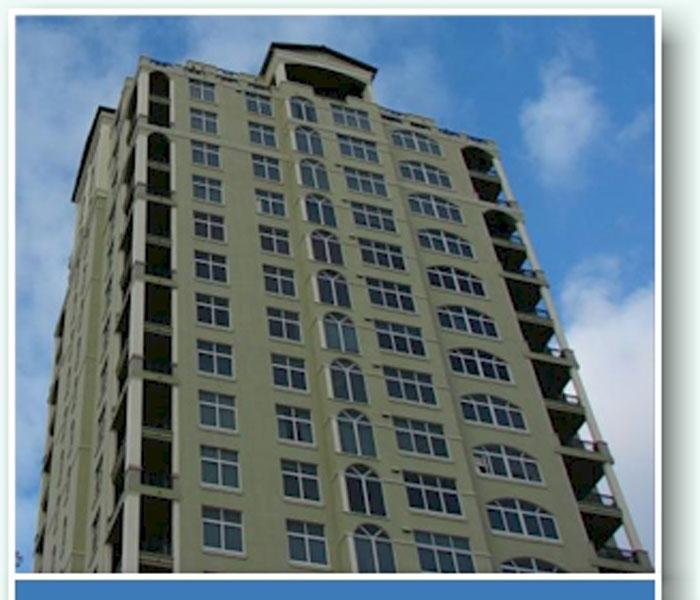 The Stovall Luxury condo was damaged by a broken sprinkler system
The Stovall Luxury condo was damaged by a broken sprinkler system
Sprinkler System Breaks, Floods Tampa Luxury Condo
For most Florida residents, they worry about flooding when a hurricane blows through and brings with it inches and inches of rain. However, for folks living in the Stovall on Bayshore Boulevard in Tampa, the flooding came from a most unexpected source--a broken sprinkler system.
On November 4th, gallon after gallon of water rolled down stairways and came through ceilings, causing millions of dollars in damages and displacing residents of all 33 units. Not only is electricity still shut off, but parts of the 22-story tower have so much standing water that the building resembles a Pirates of the Caribbean attraction at Disney. The accident, caused when a worker fell off scaffolding and grabbed a sprinkler pipe to break his fall, has caused residents to find living quarters wherever they can. Some are staying in hotels, while others are living in second homes or staying with friends or relatives.
According to condominium association president Gloria Giunta, despite the extensive damage to the building, it is expected to be fully repaired no later than Christmas. On that fateful Tuesday morning, Giunta was not at the Stovall but soon found her cell phone going crazy with calls from residents telling her about the crisis. Needless to say, she rushed back there only to find the place flooded with water and Tampa Fire and Rescue Personnel. Witnesses reported water dripping from light fixtures, staircases that resembled waterfalls and apartment after apartment with several inches of standing water. Despite firefighters reaching the main sprinkler pump and shutting it off, the damage was already done. As Tampa Fire and Rescue spokesman Jason Terry said, "You can't turn off gravity."
Fortunately for residents, SERVPRO responded to the scene and immediately began to set up fans and dehumidifiers to begin the cleanup and repair process. Crews from SERVPRO of West Brevard in South Florida assisted with the massive job of getting the building stabilized for additional repairs. With water and electricity shut off to all the tower's units, the repair process is slow at times yet steady. Some units are damaged more than others, with the biggest problems being damage to the building's electrical system and repairing wooden floors that are warped. Despite all the damage, some units are considered habitable. However, since there is no electricity in the building, most residents chose to live elsewhere while repairs are made.
The good news in all this is that no one, including the worker who fell, was injured during this incident. In addition, repair costs are expected to be covered by homeowner's and contractor's insurance policies. The building, completed in 2001, is home to many of Tampa's most prominent citizens including former University of Tampa president Bruce Samson. According to Giunta, the residents are very close-knit because there are only two units per floor, allowing people to get to know each other very well.
So while the incident made life very unpleasant in many ways, there was a bright side to the whole thing. Because of the damage to the Stovall's electrical system, the elevators were out for quite awhile. Due to this, people were forced to use the stairs more often, with many of them reporting losing a few pounds while getting fitter along the way. So when life gave these residents lemons, they simply made lemonade.






 24/7 Emergency Service
24/7 Emergency Service















